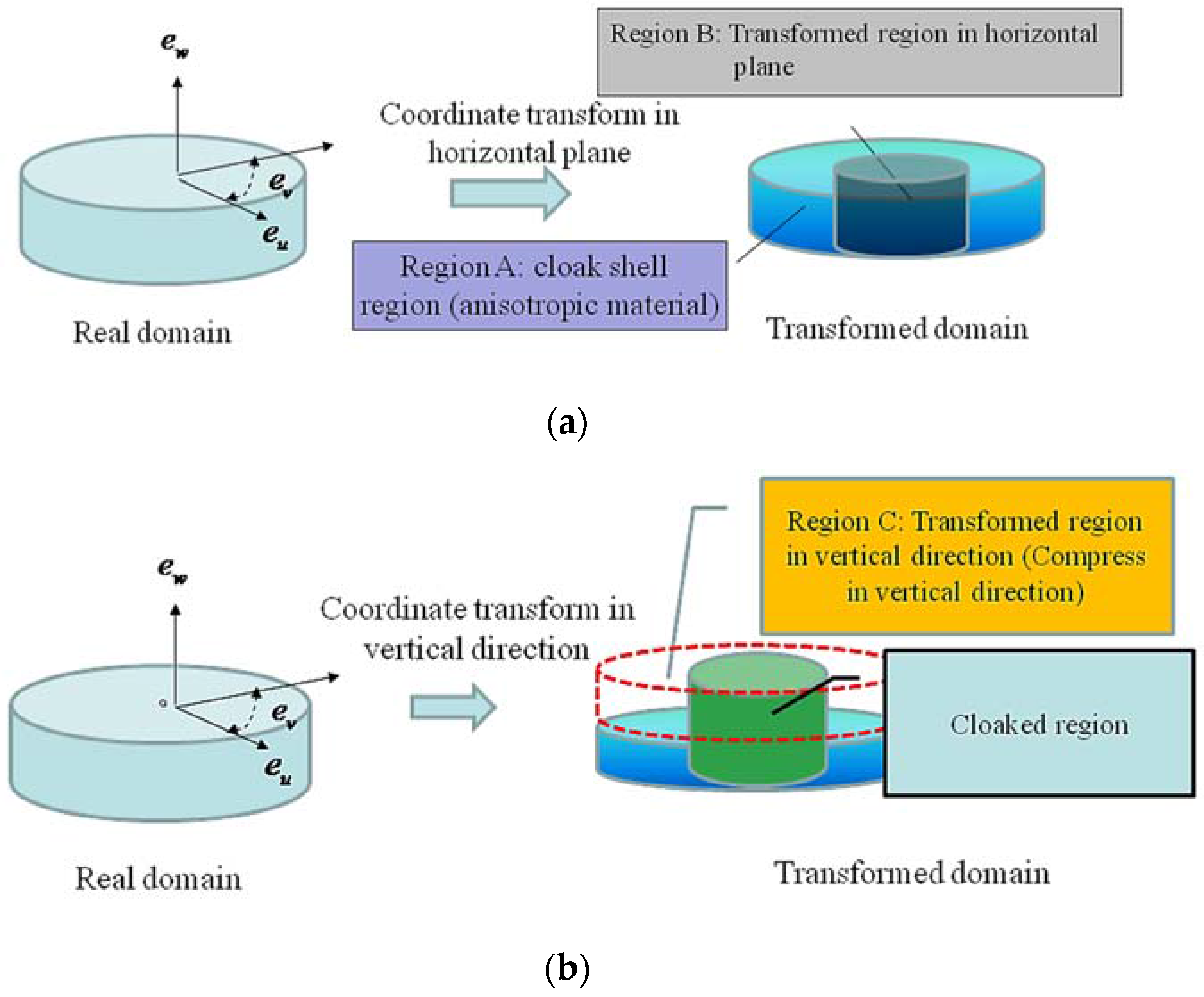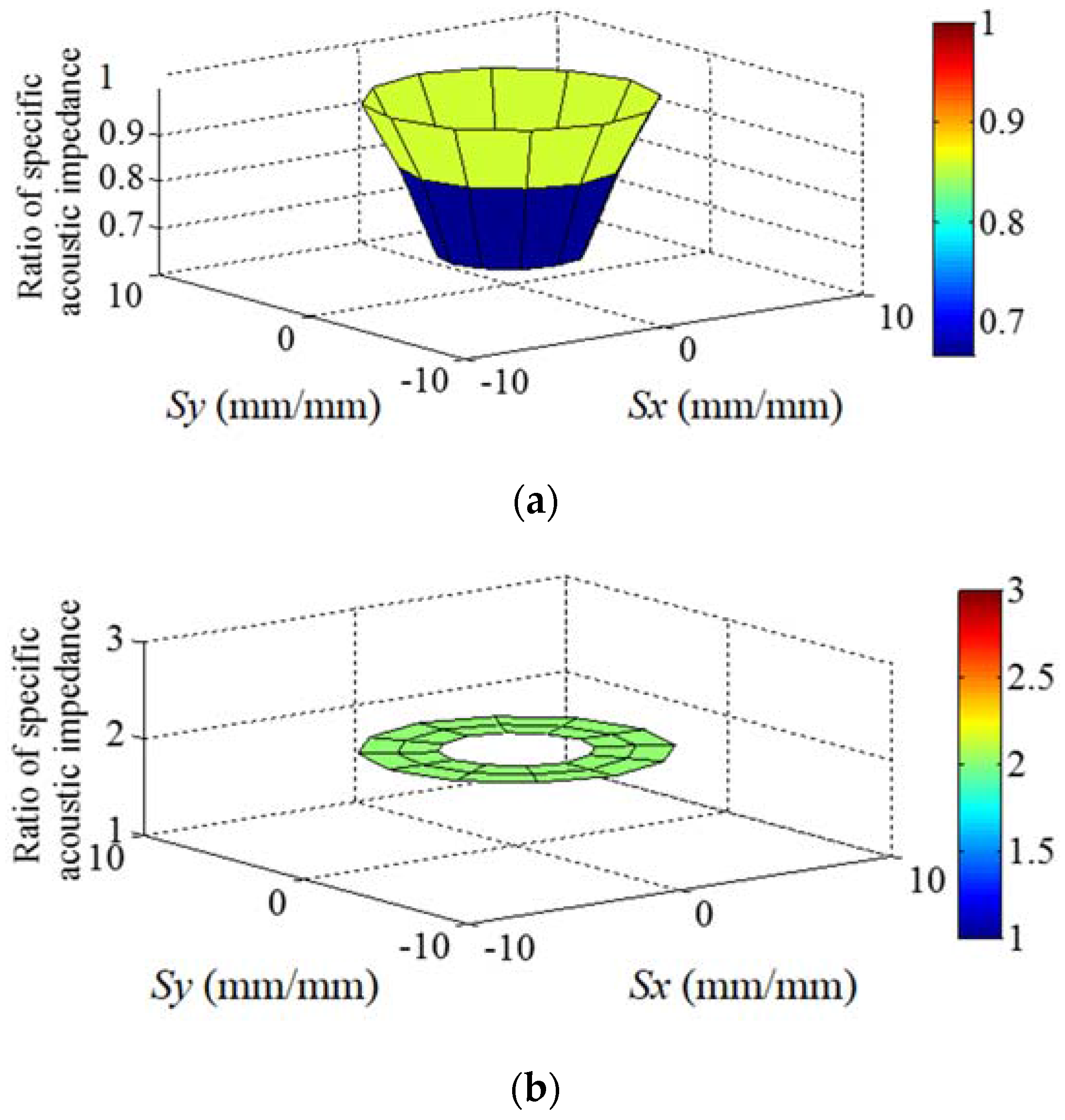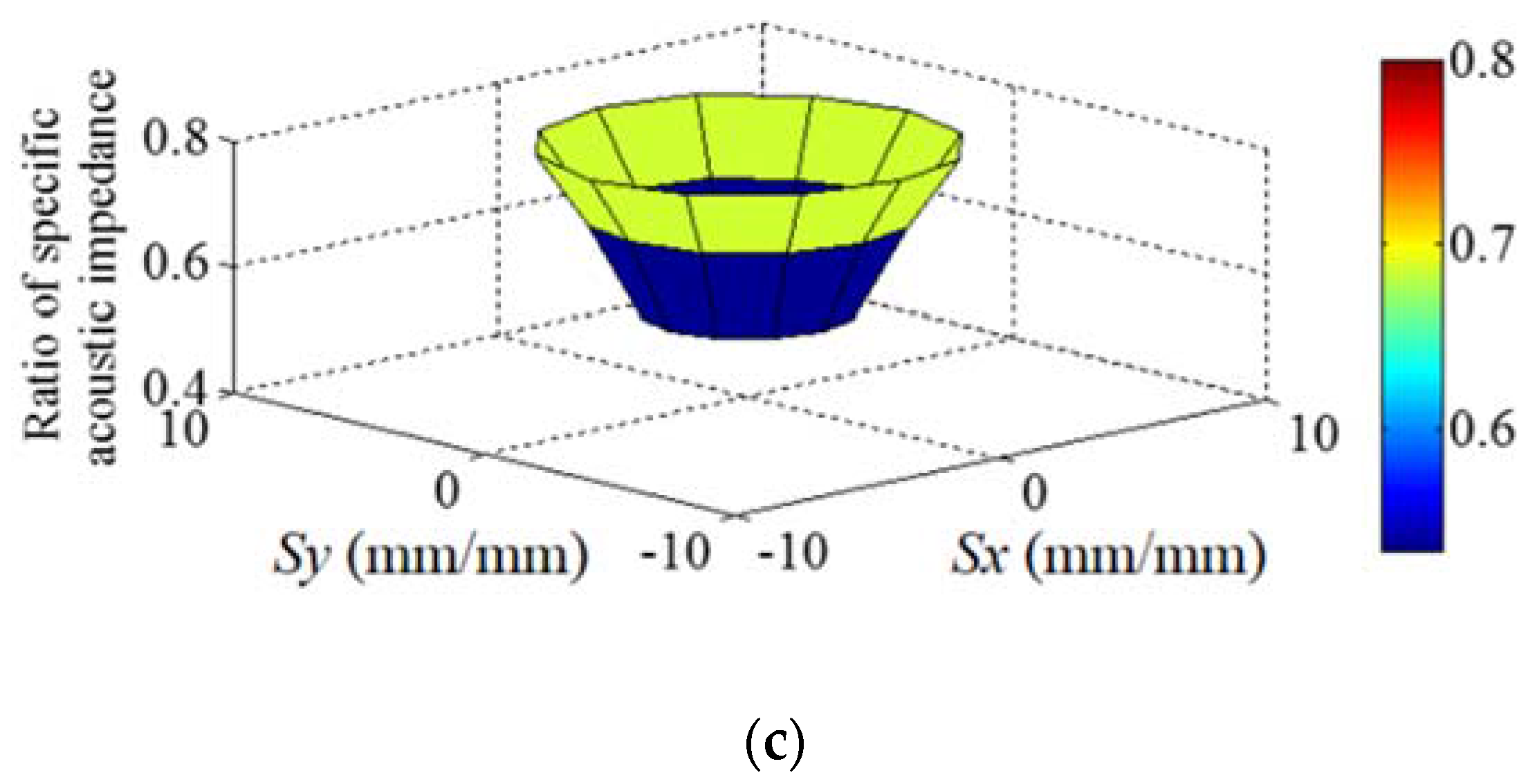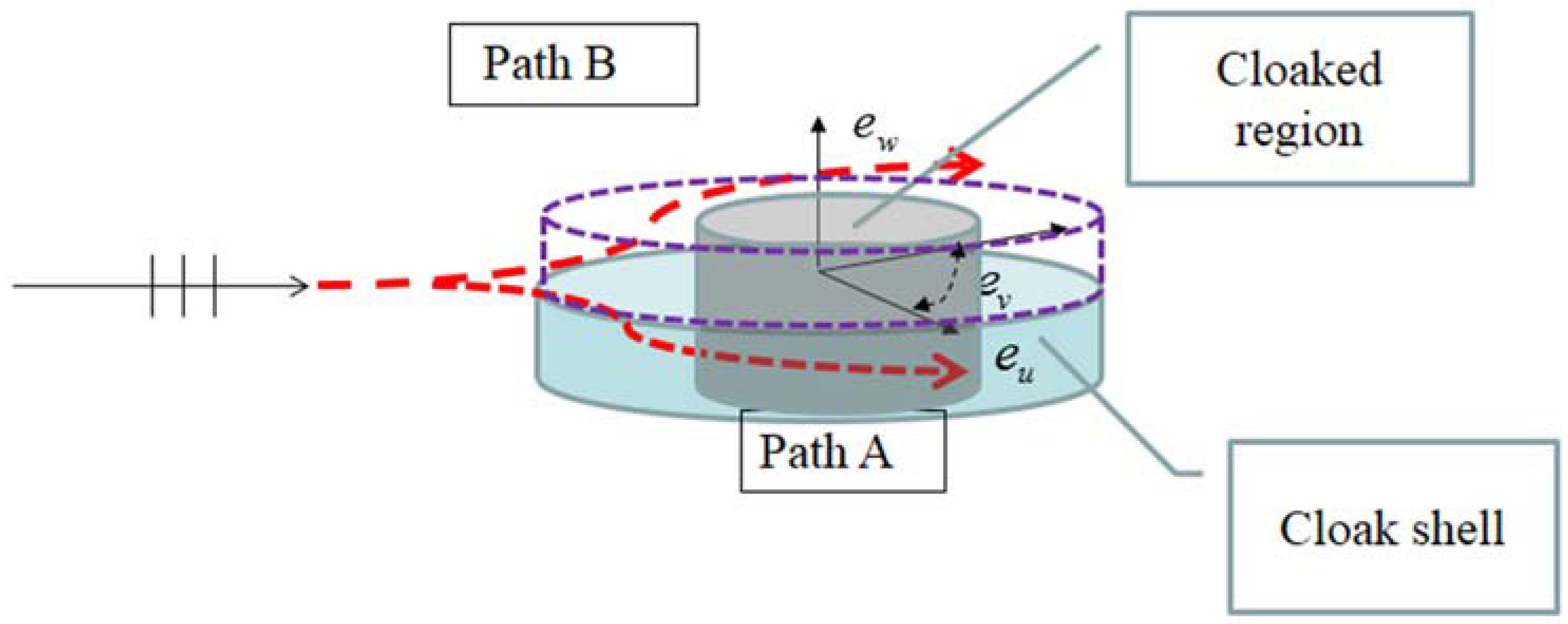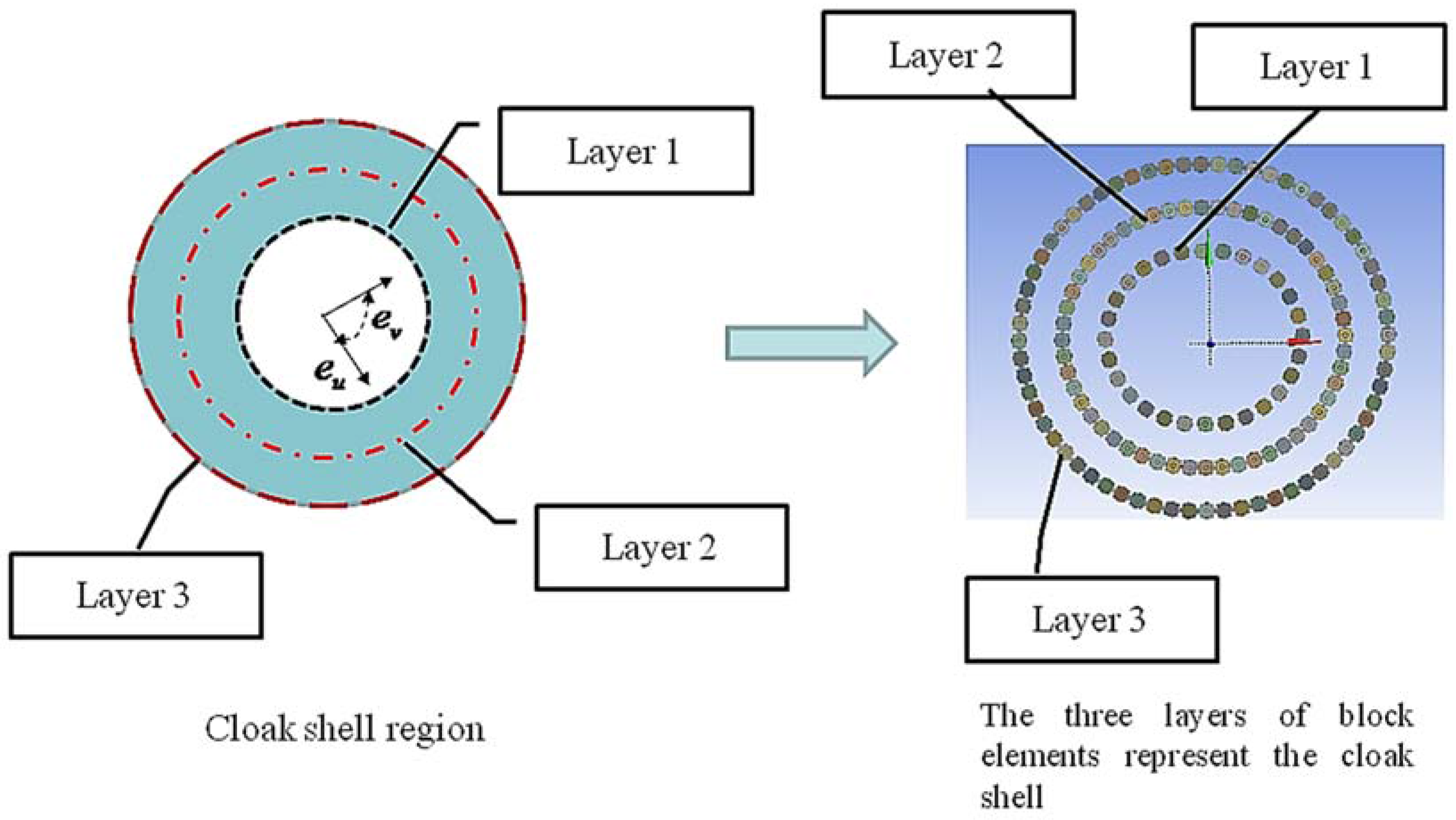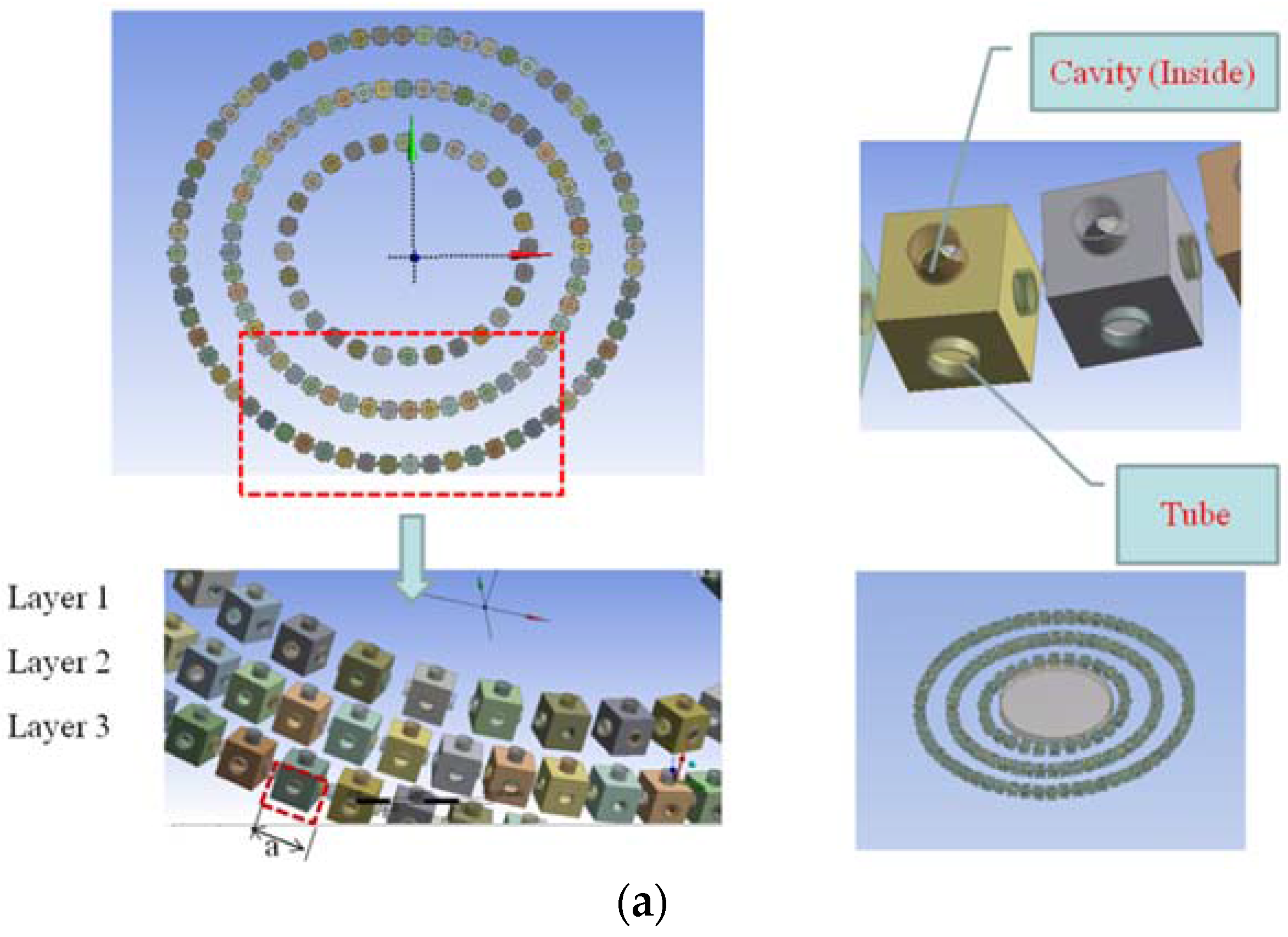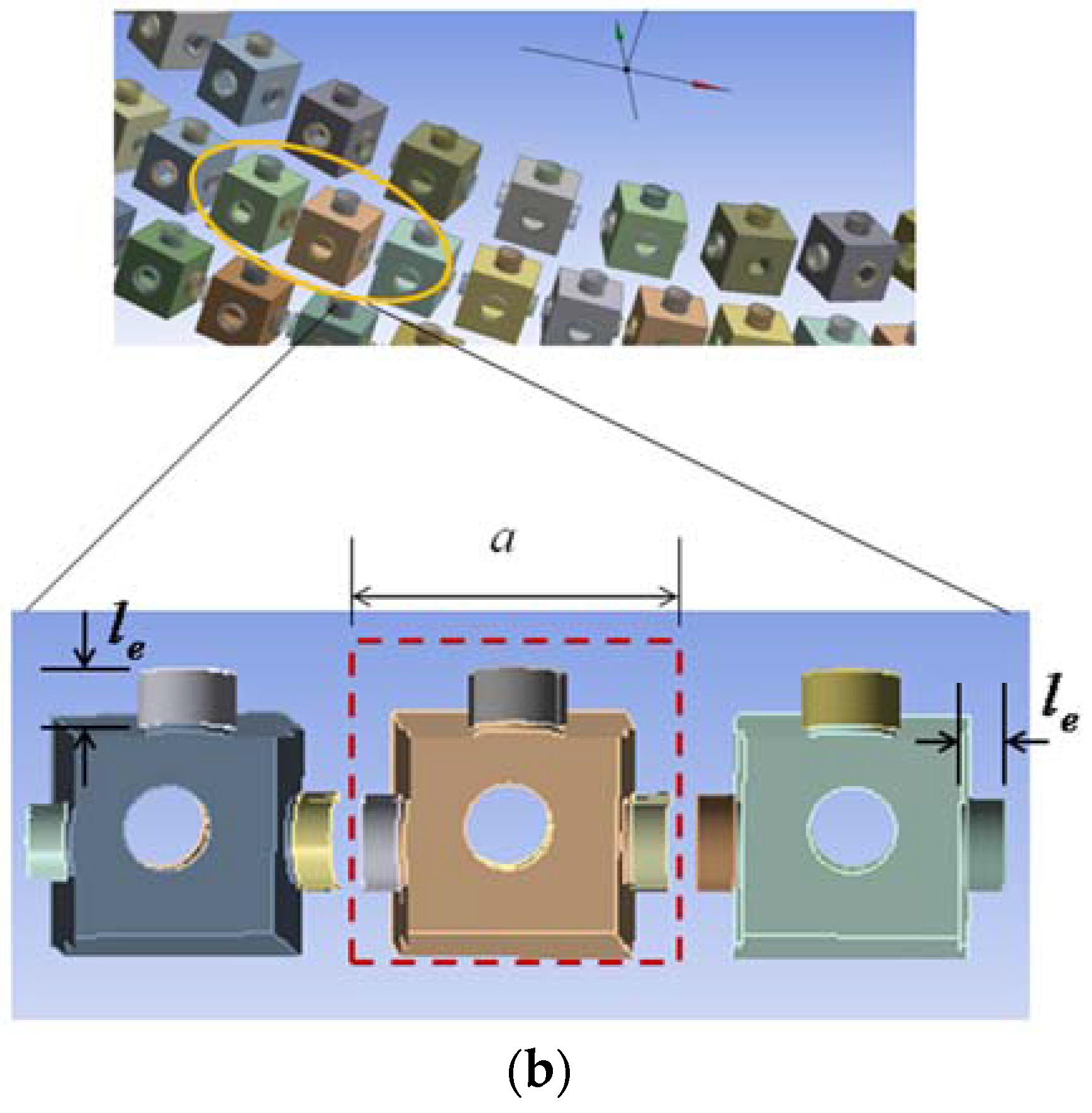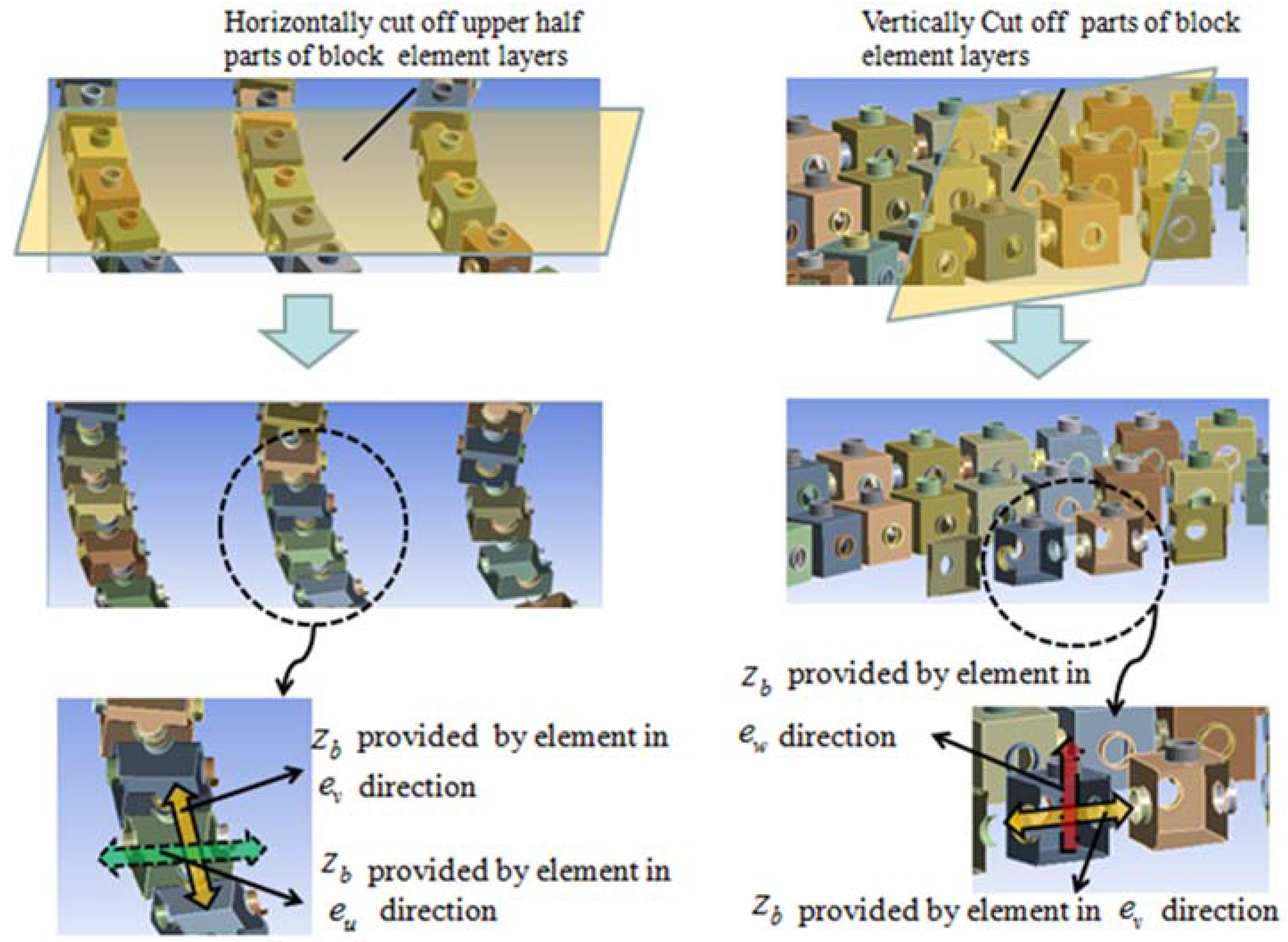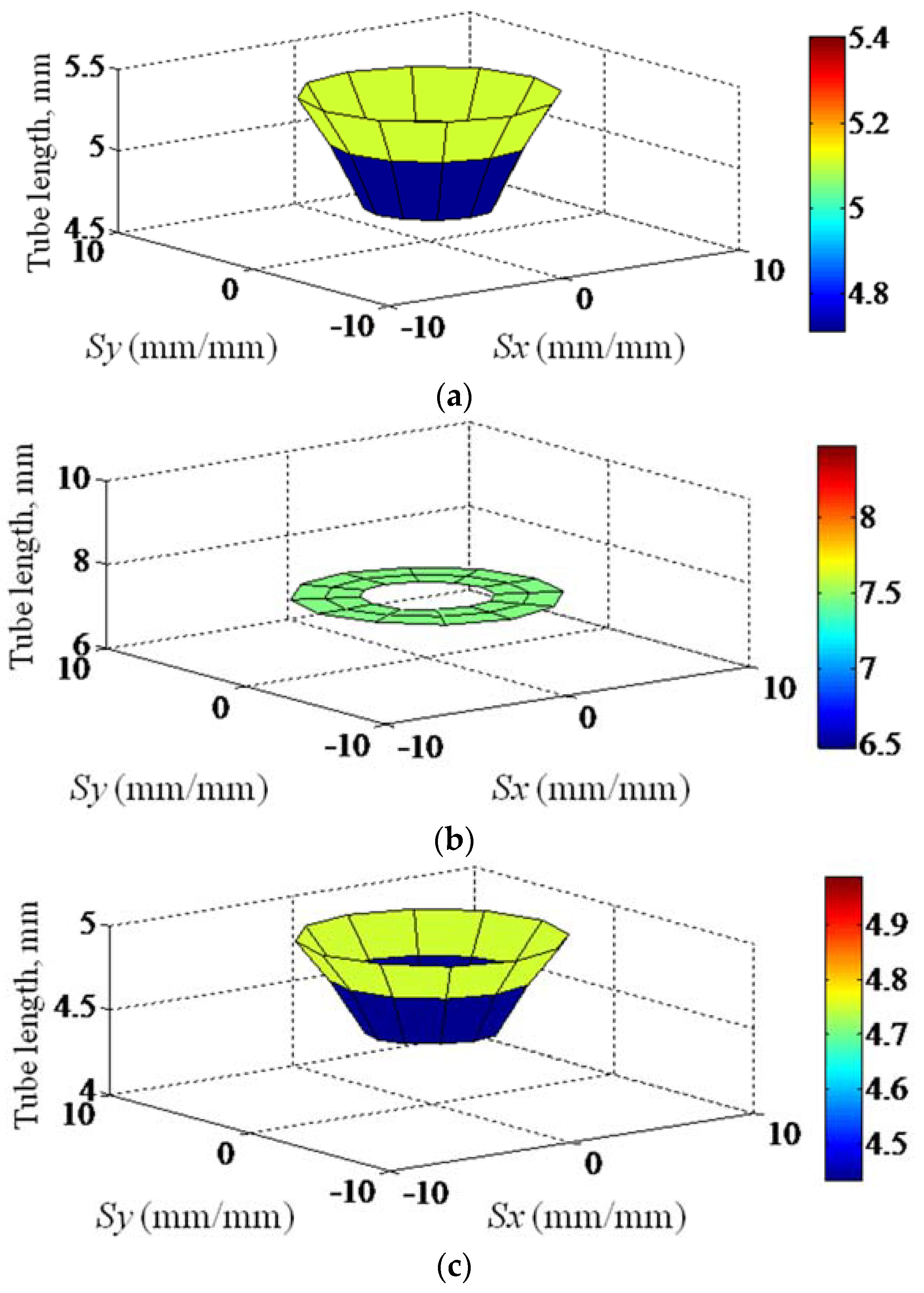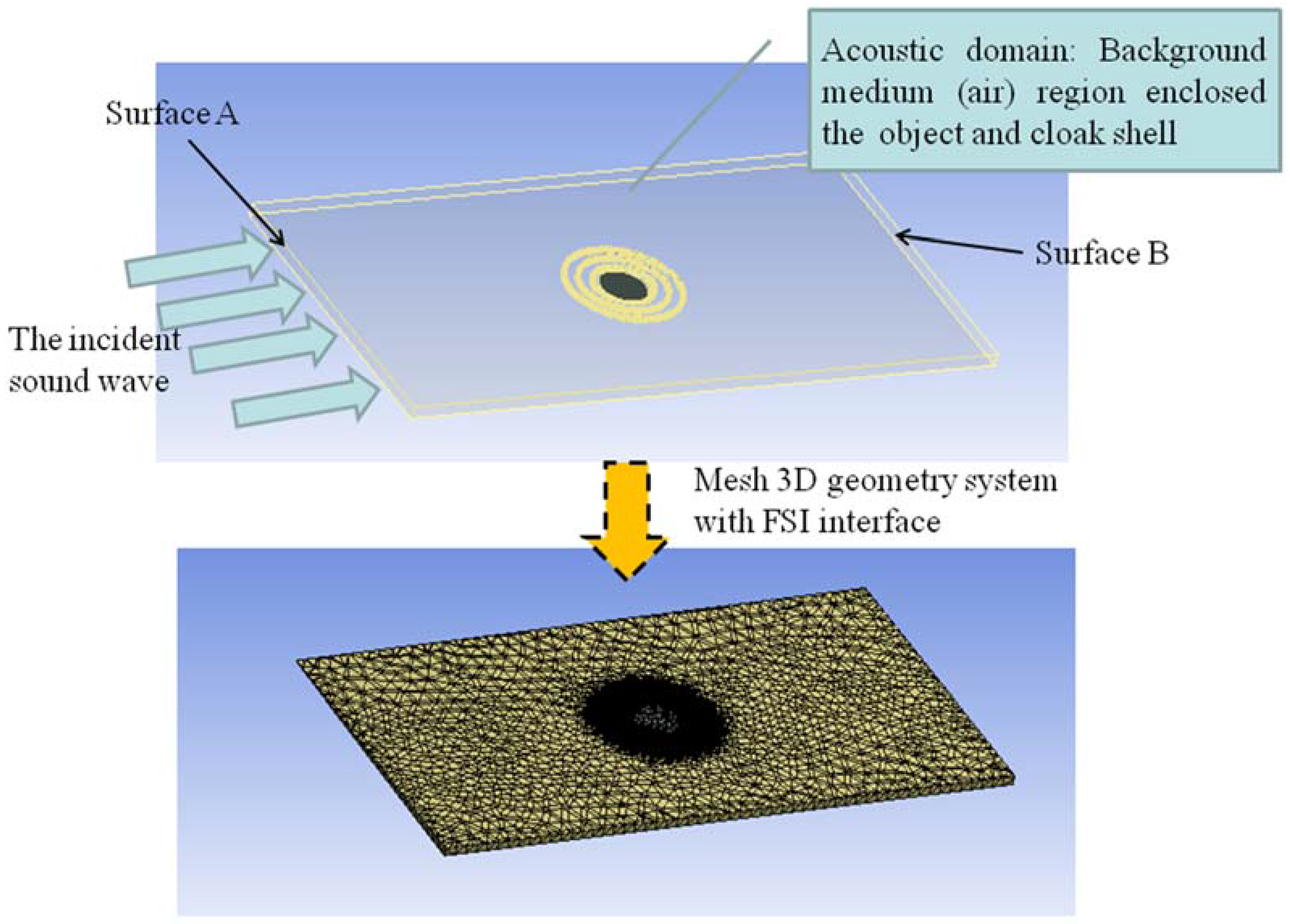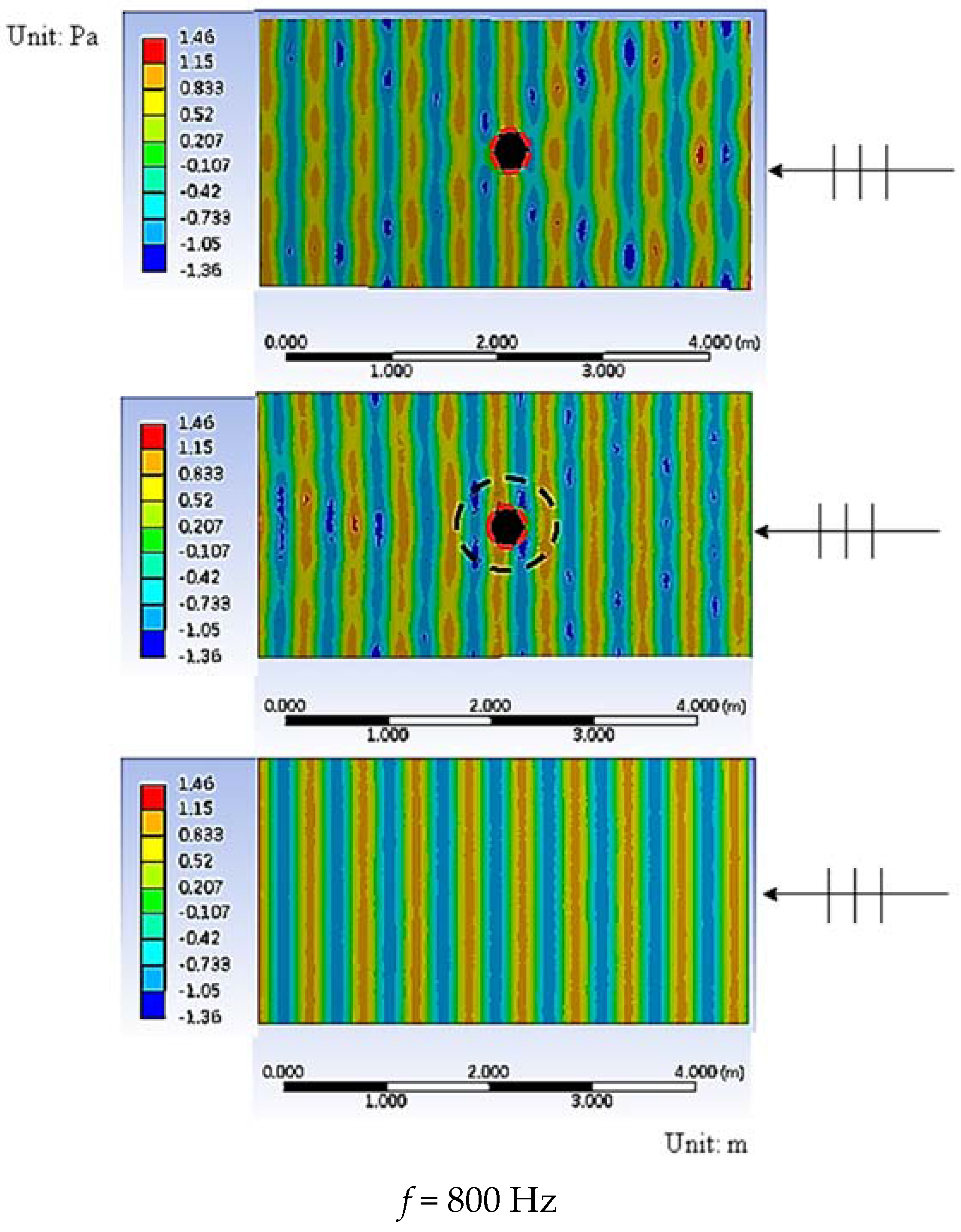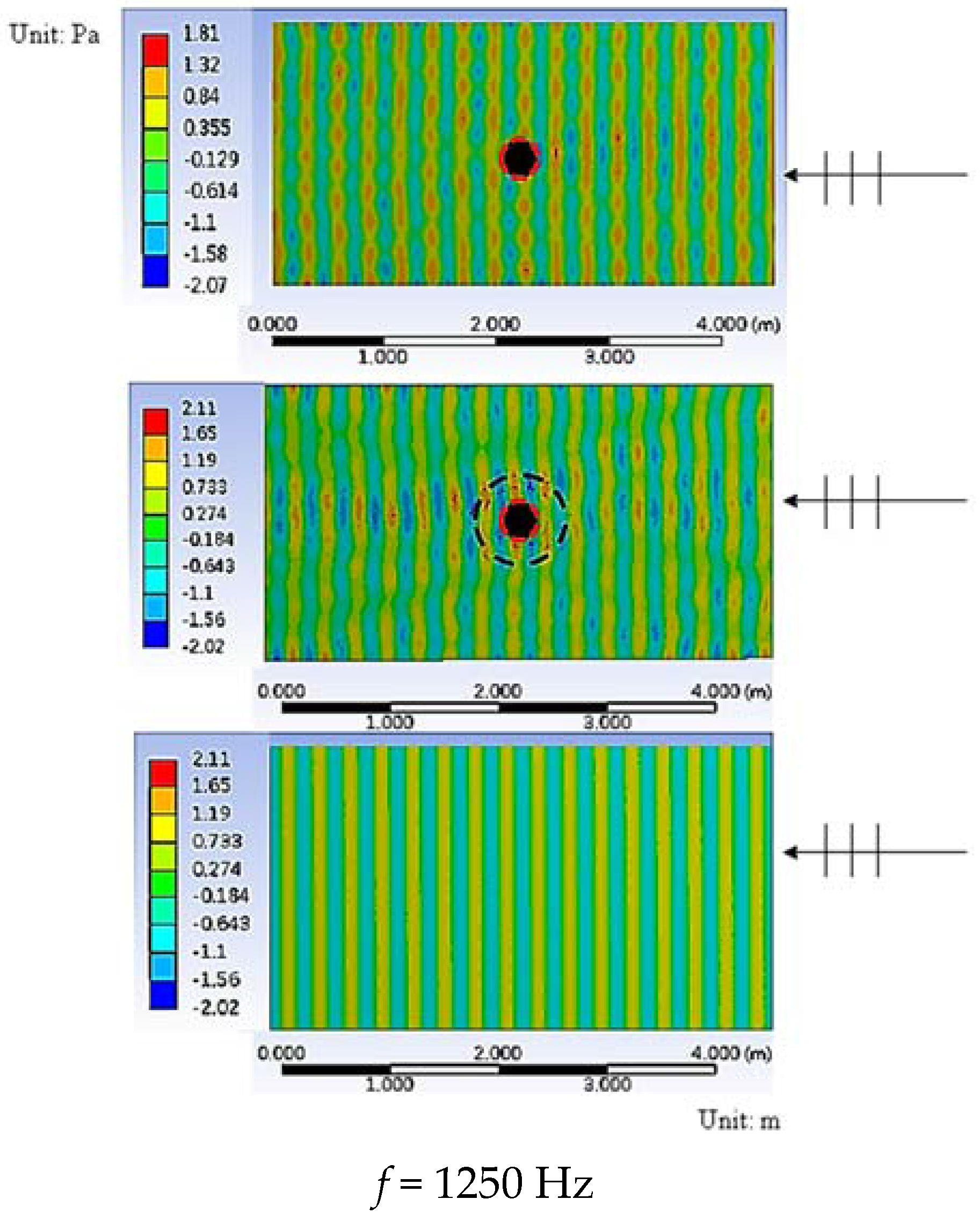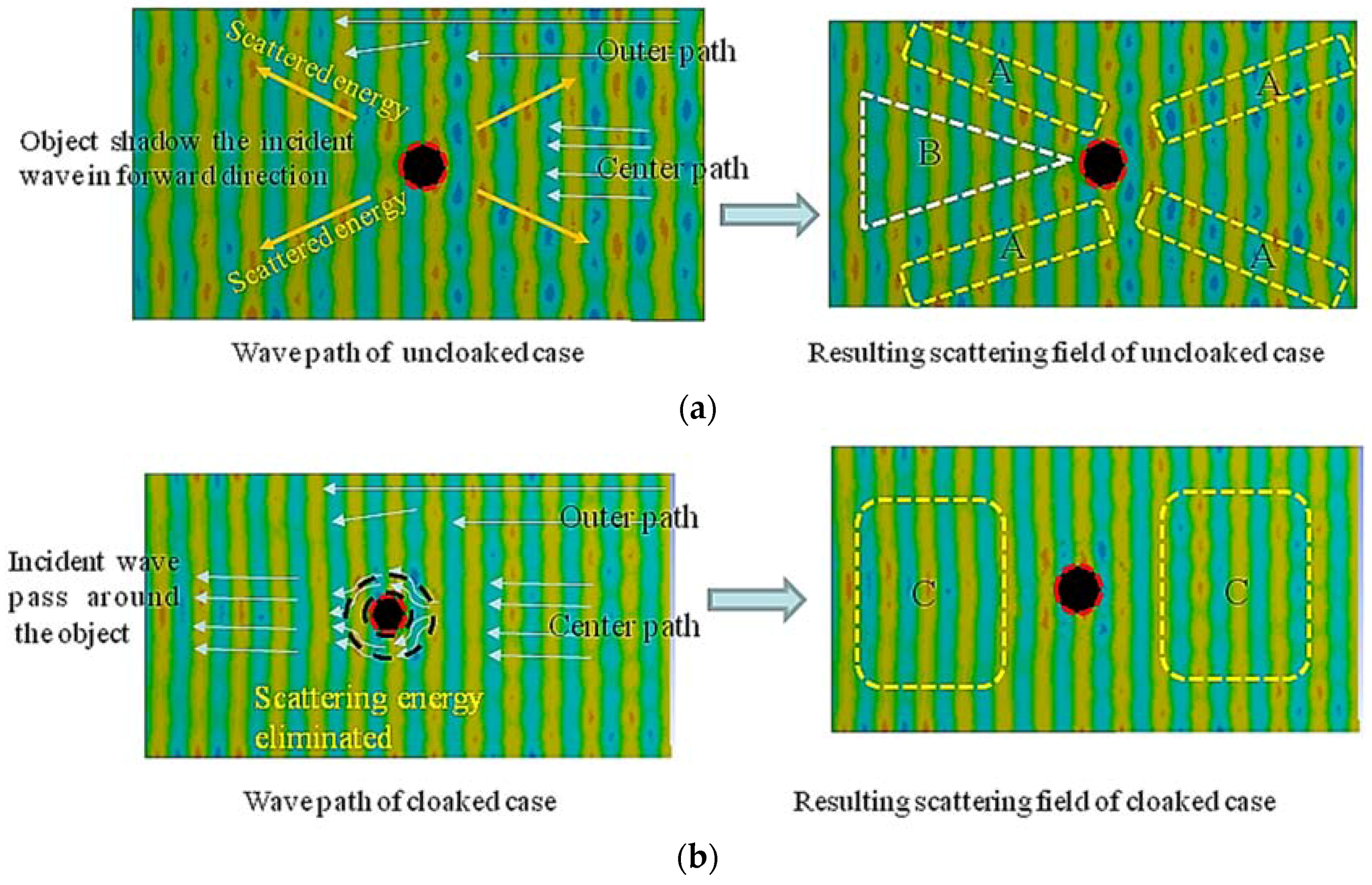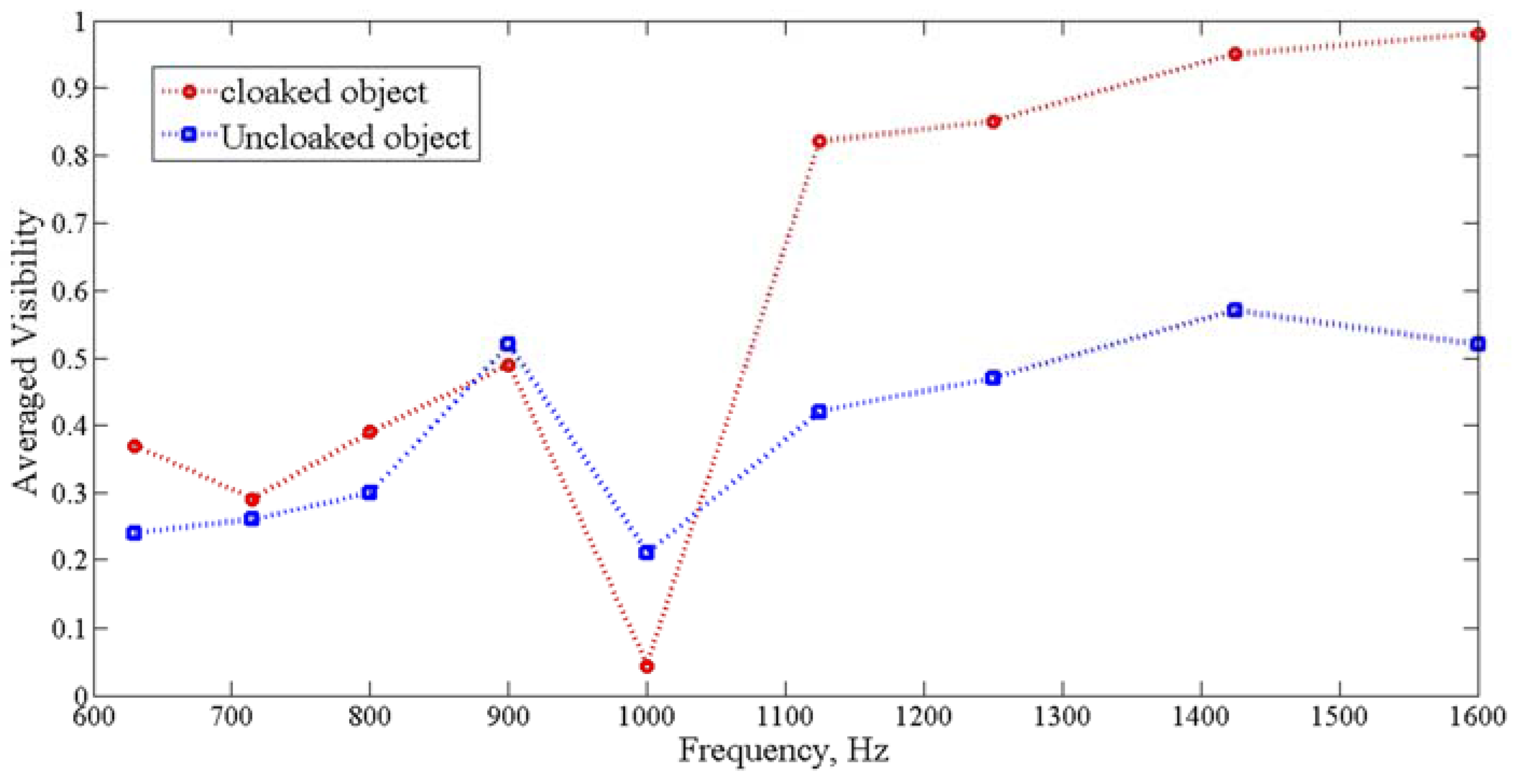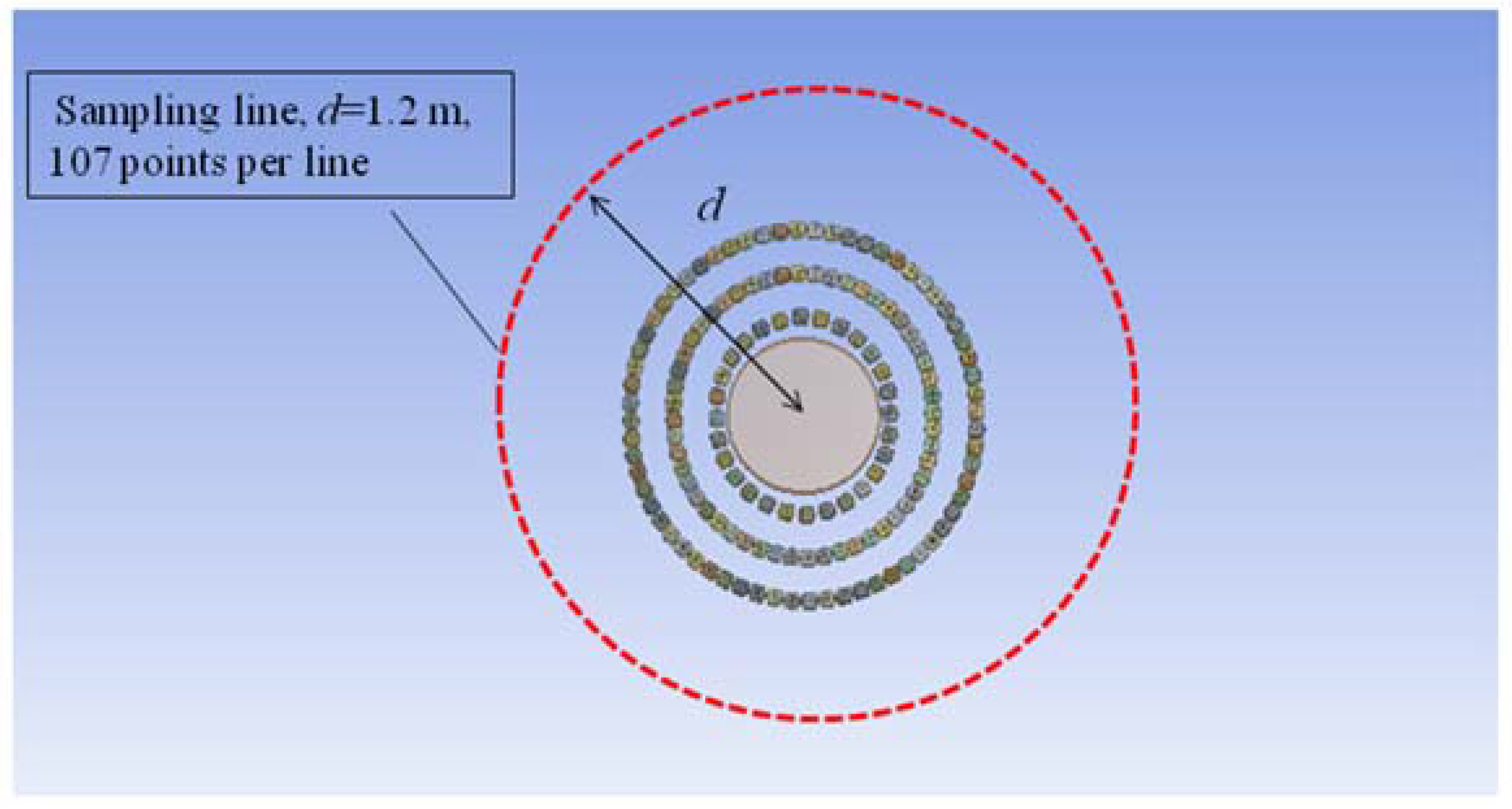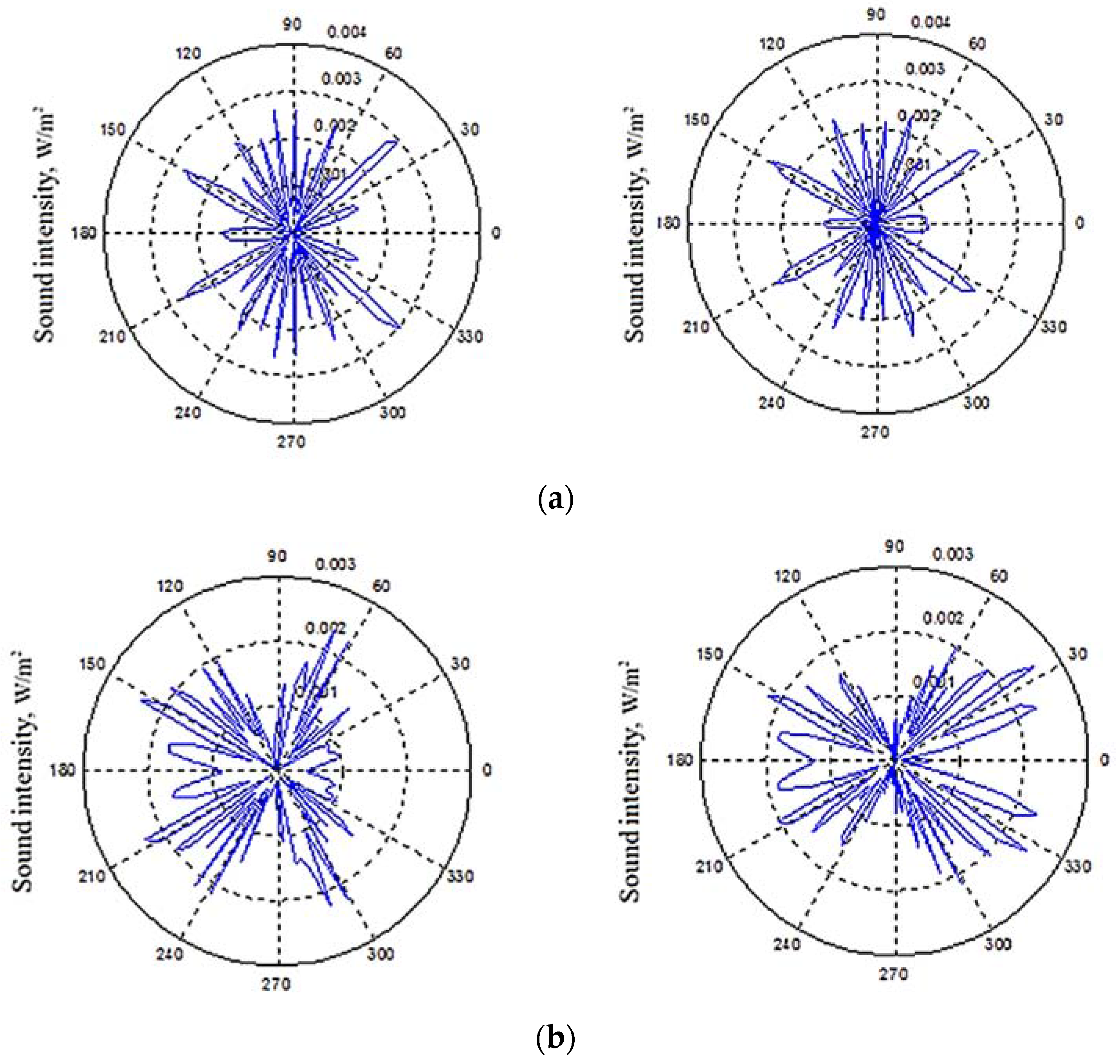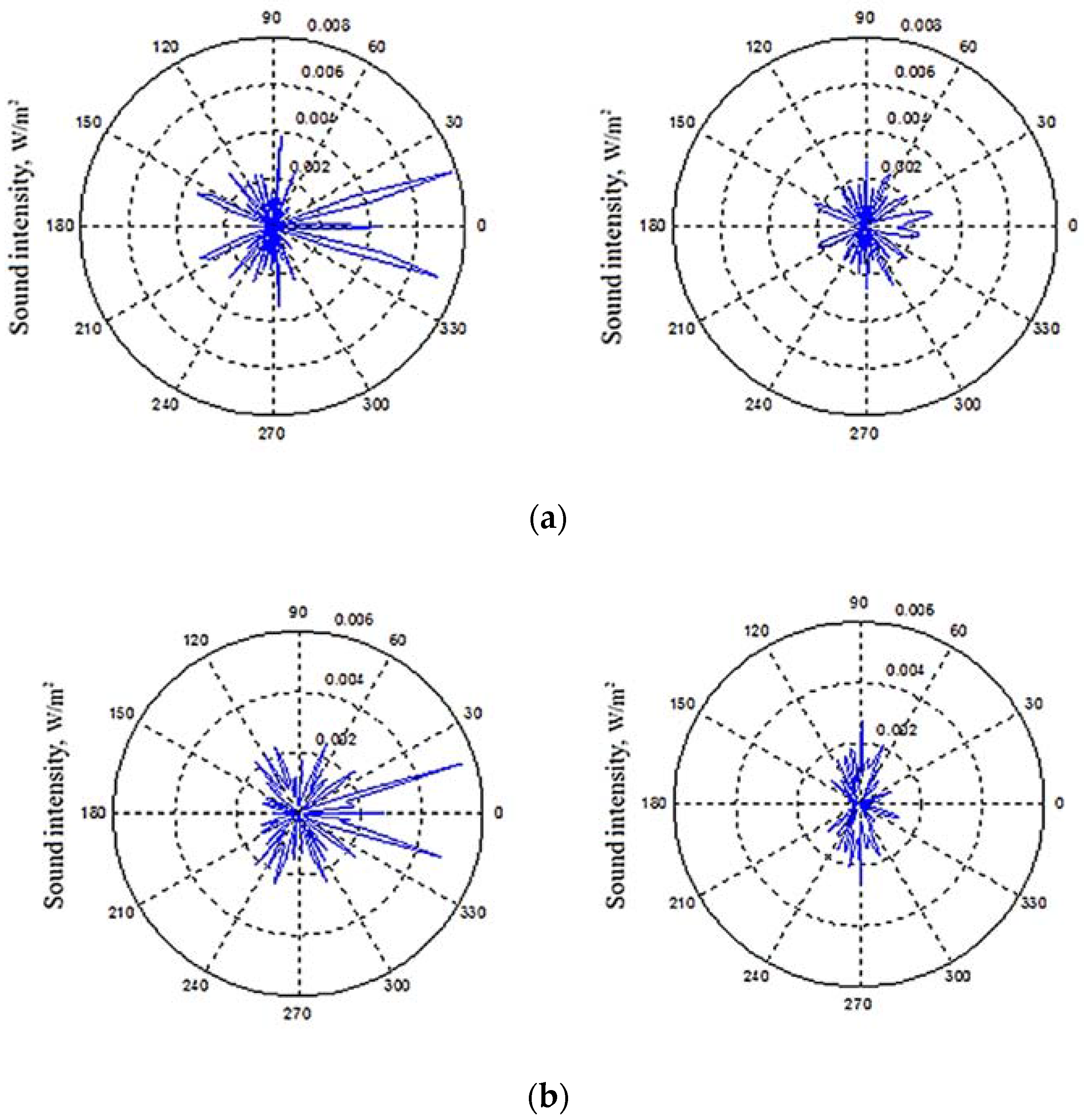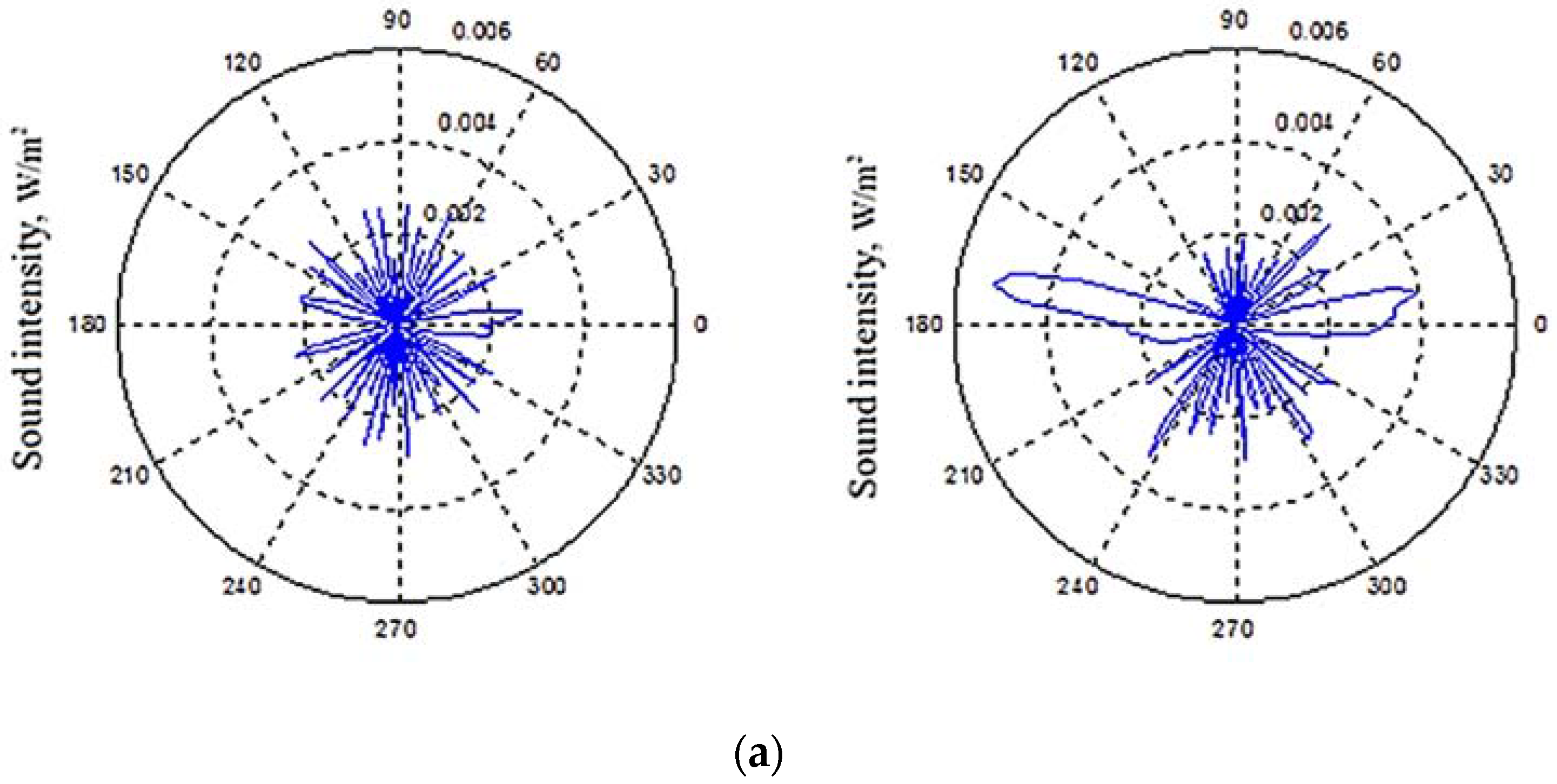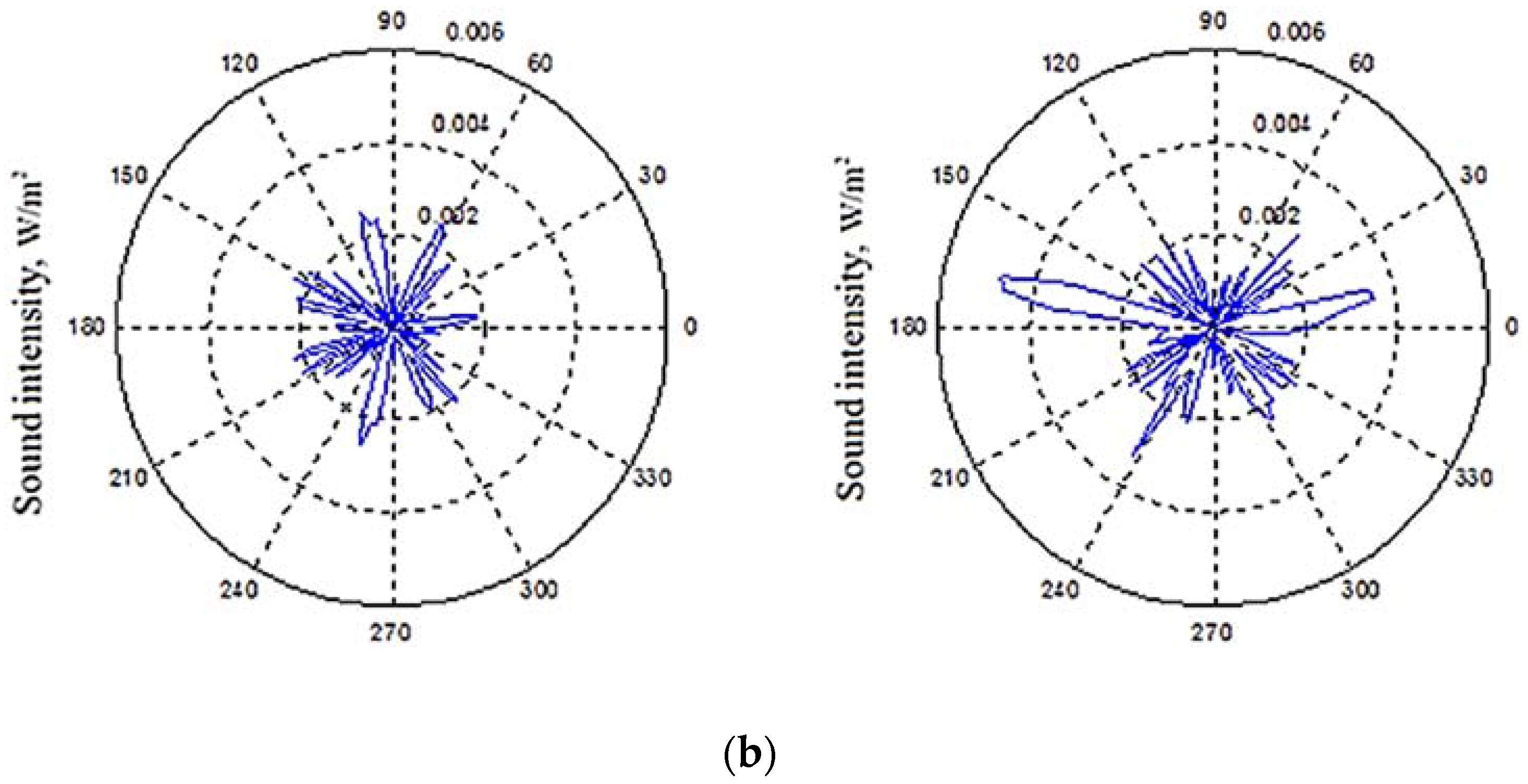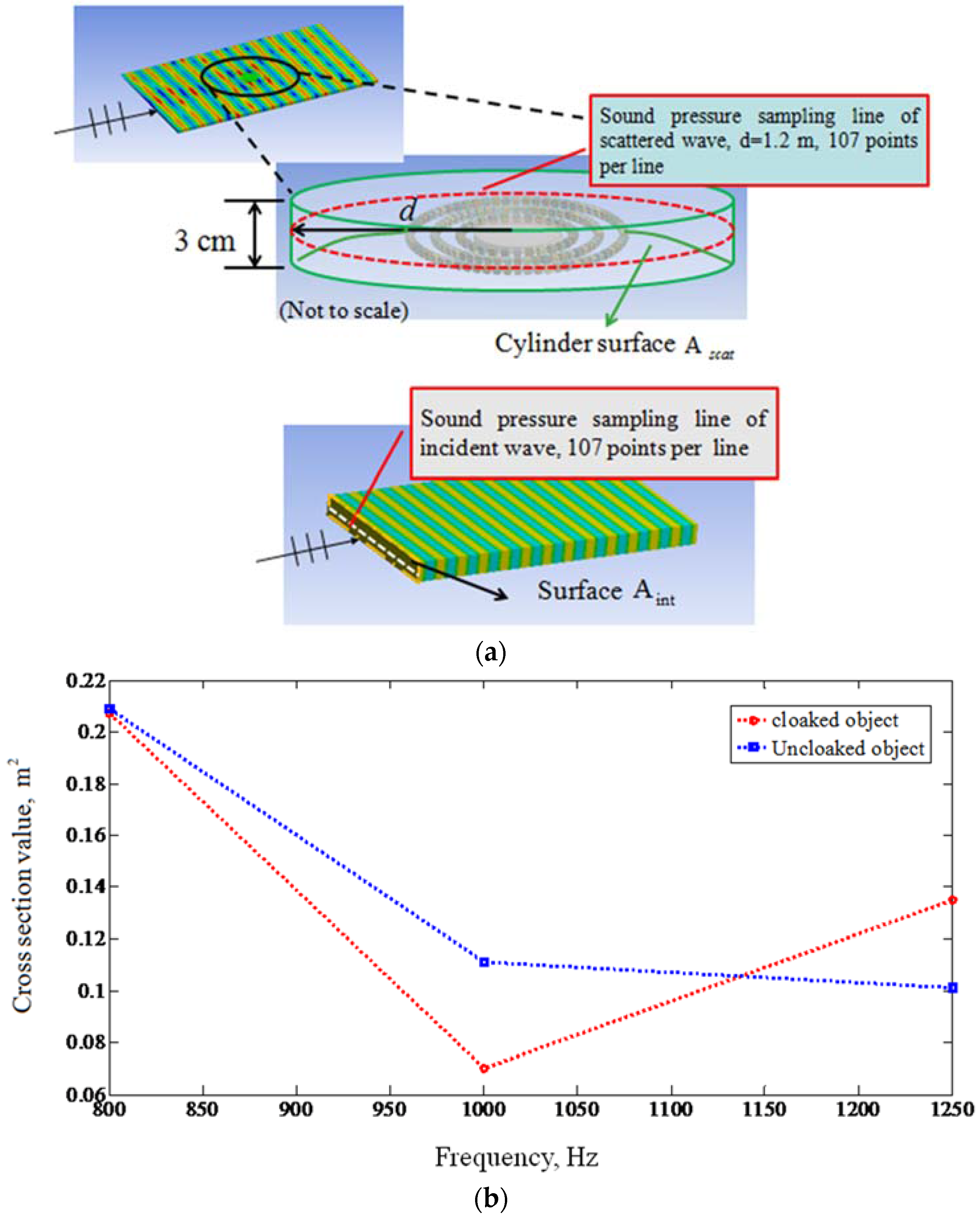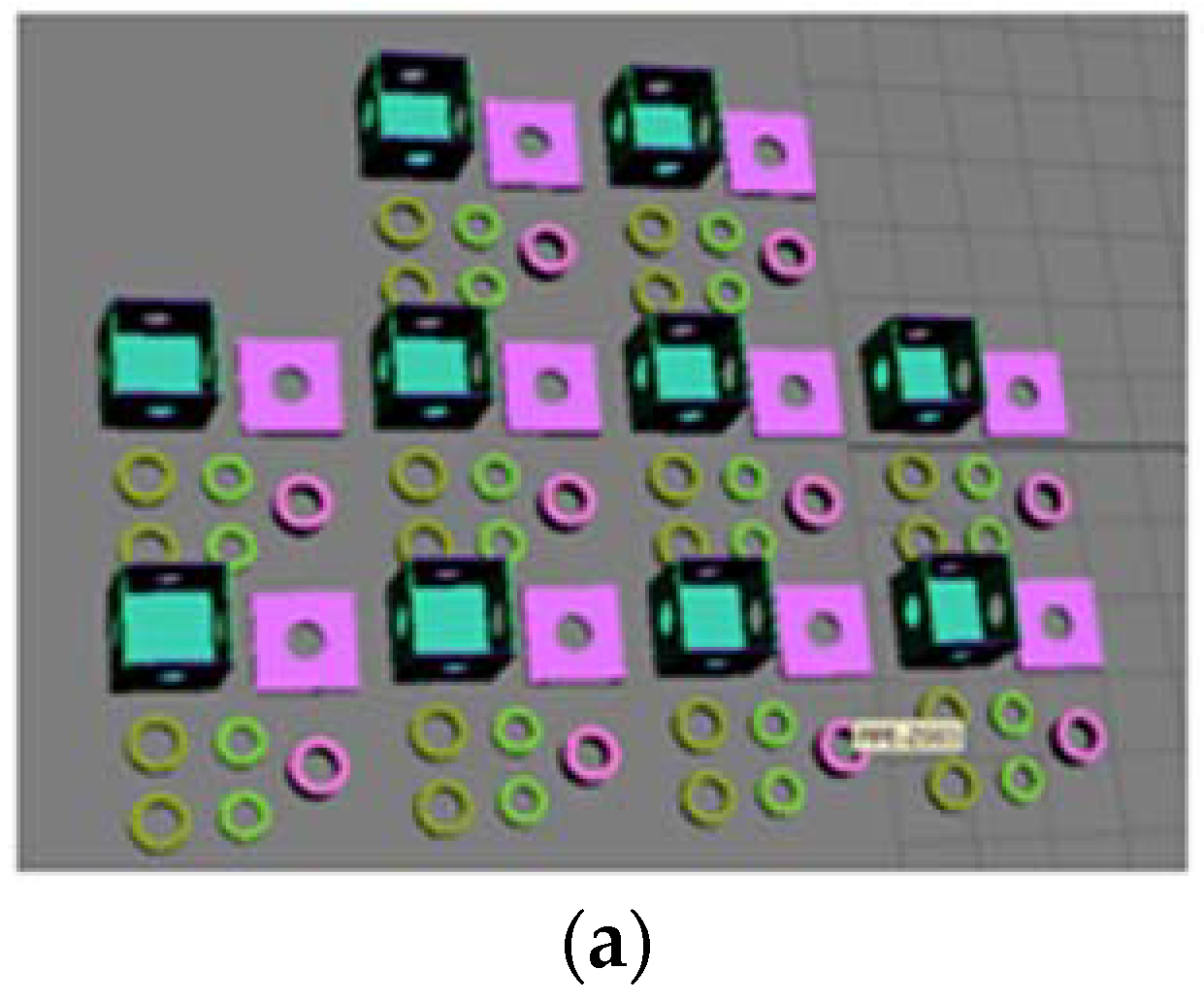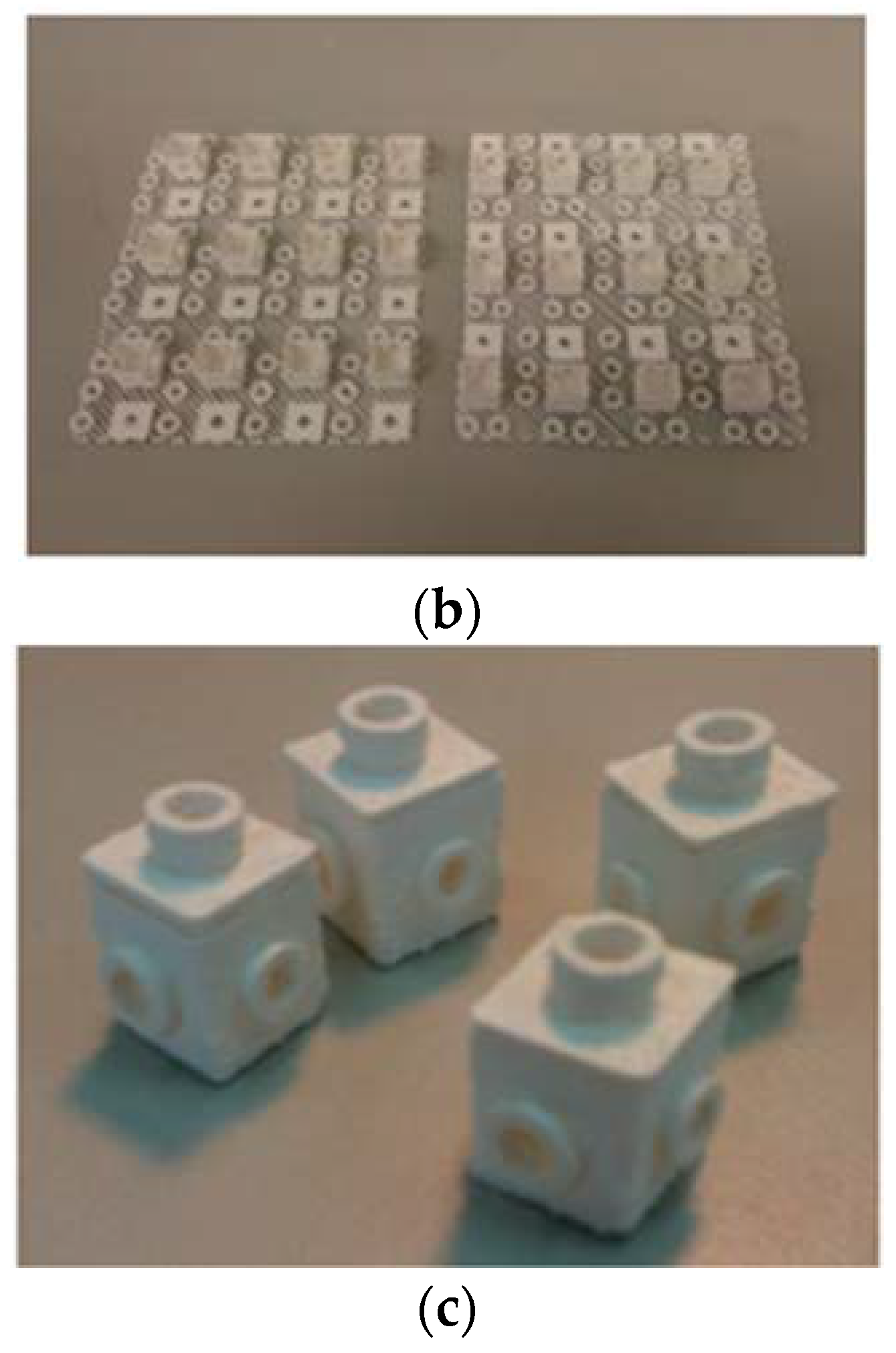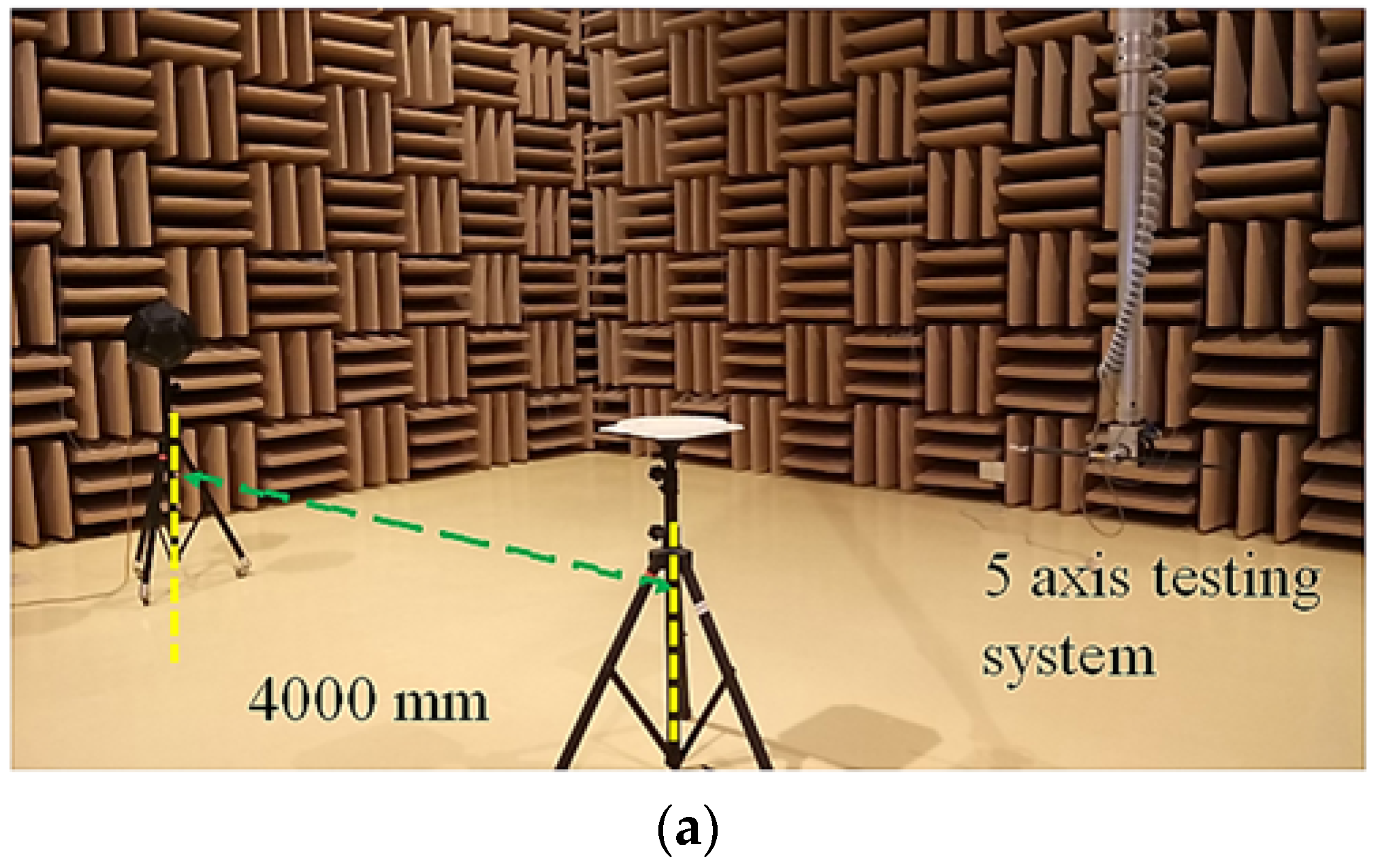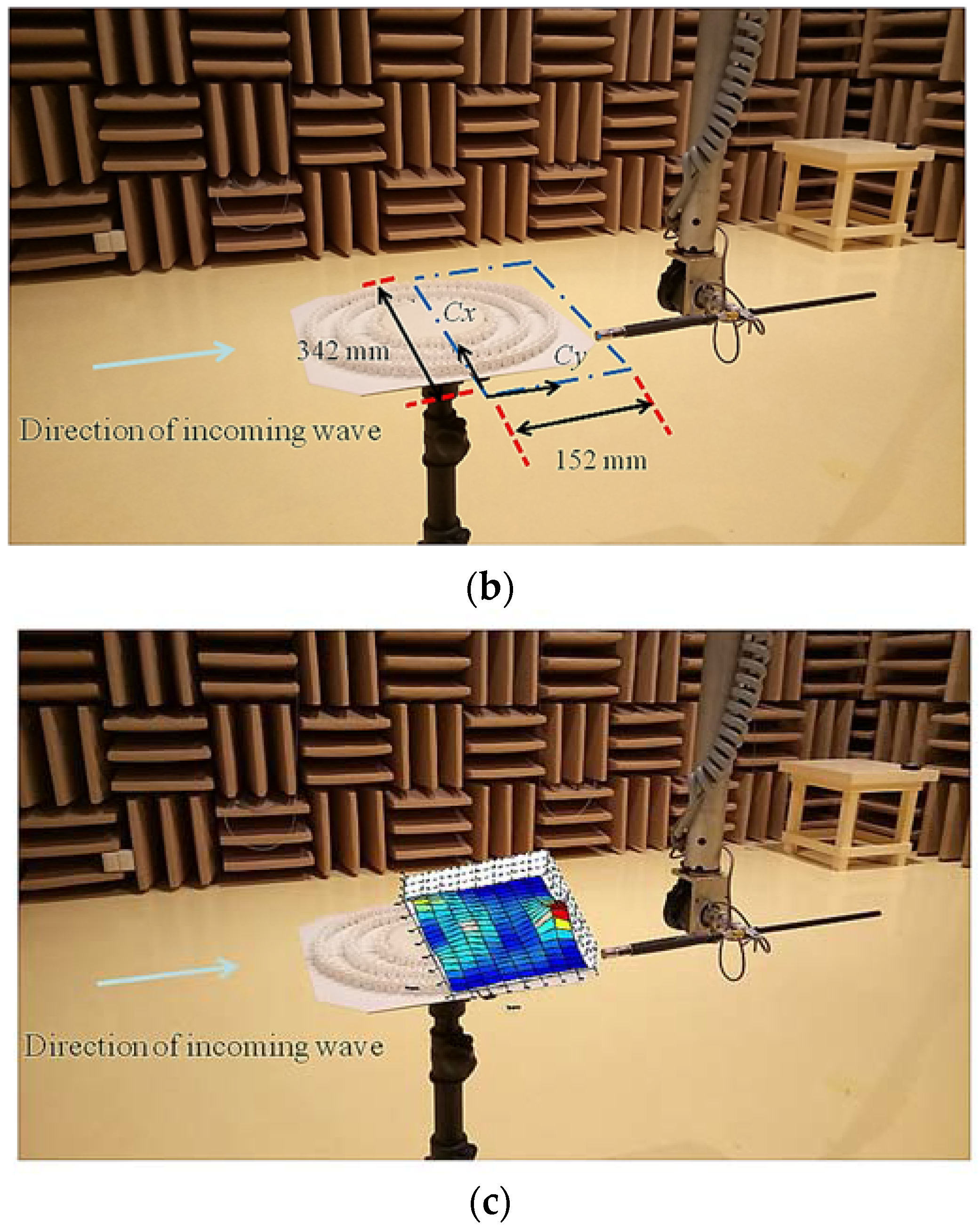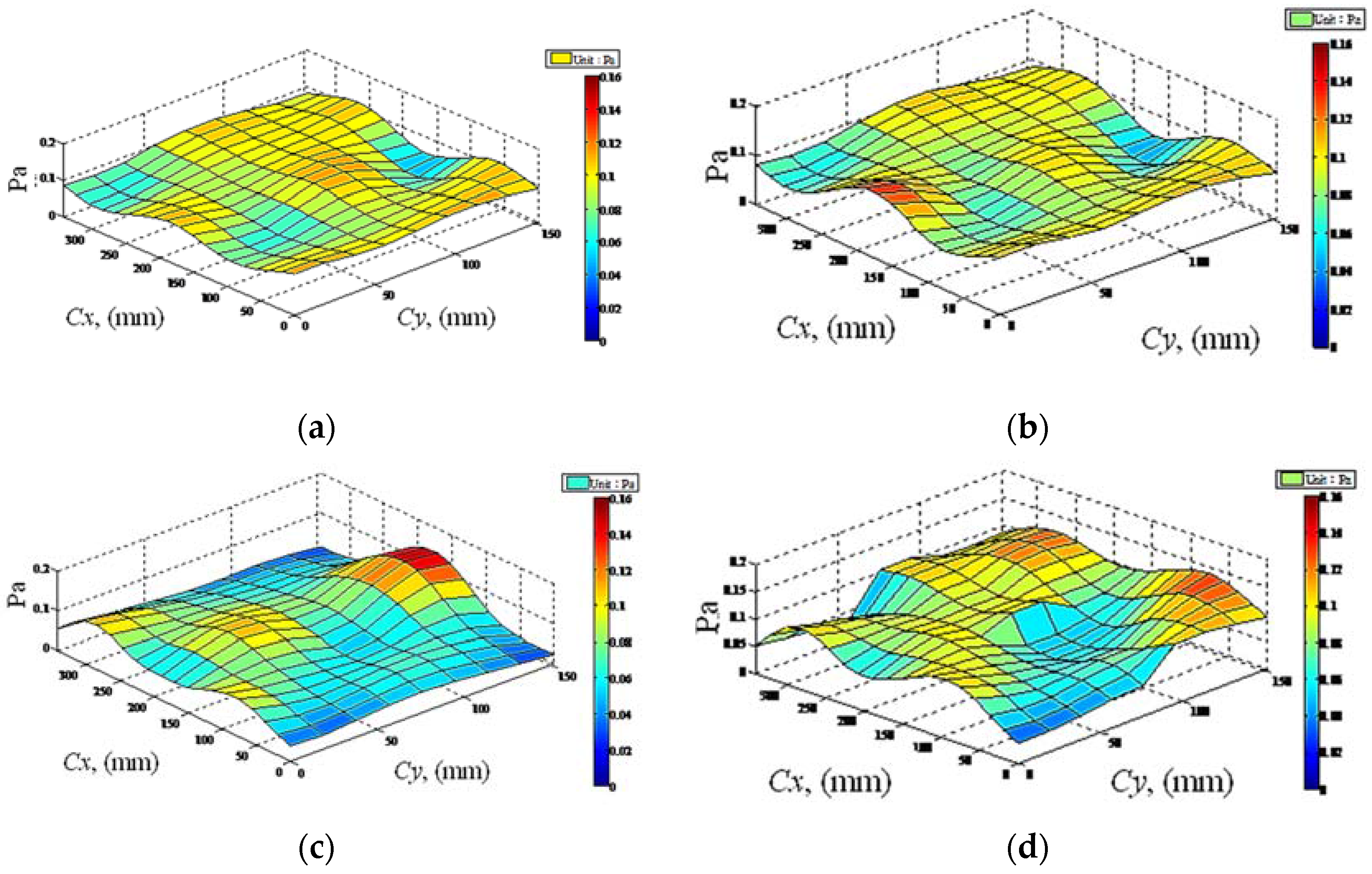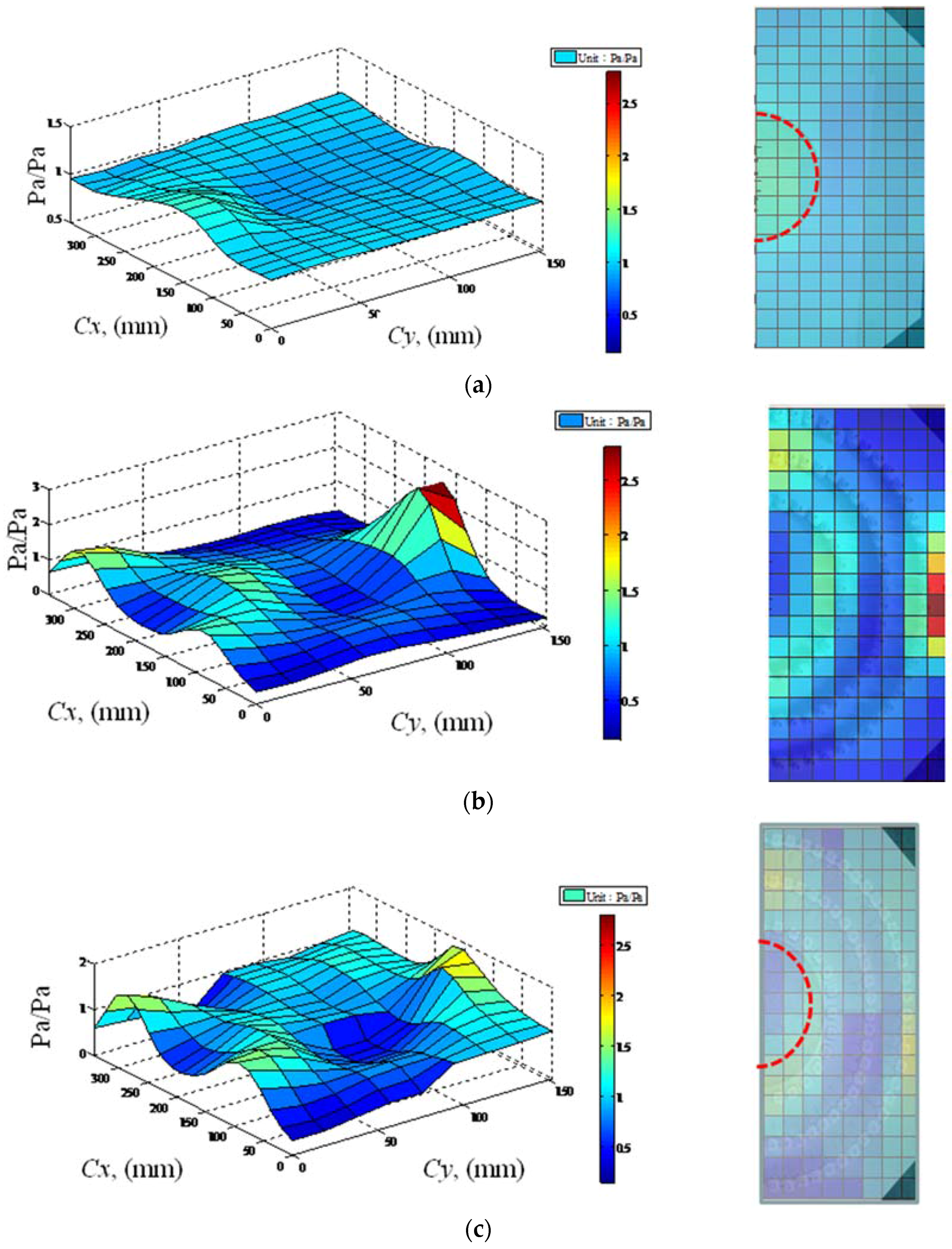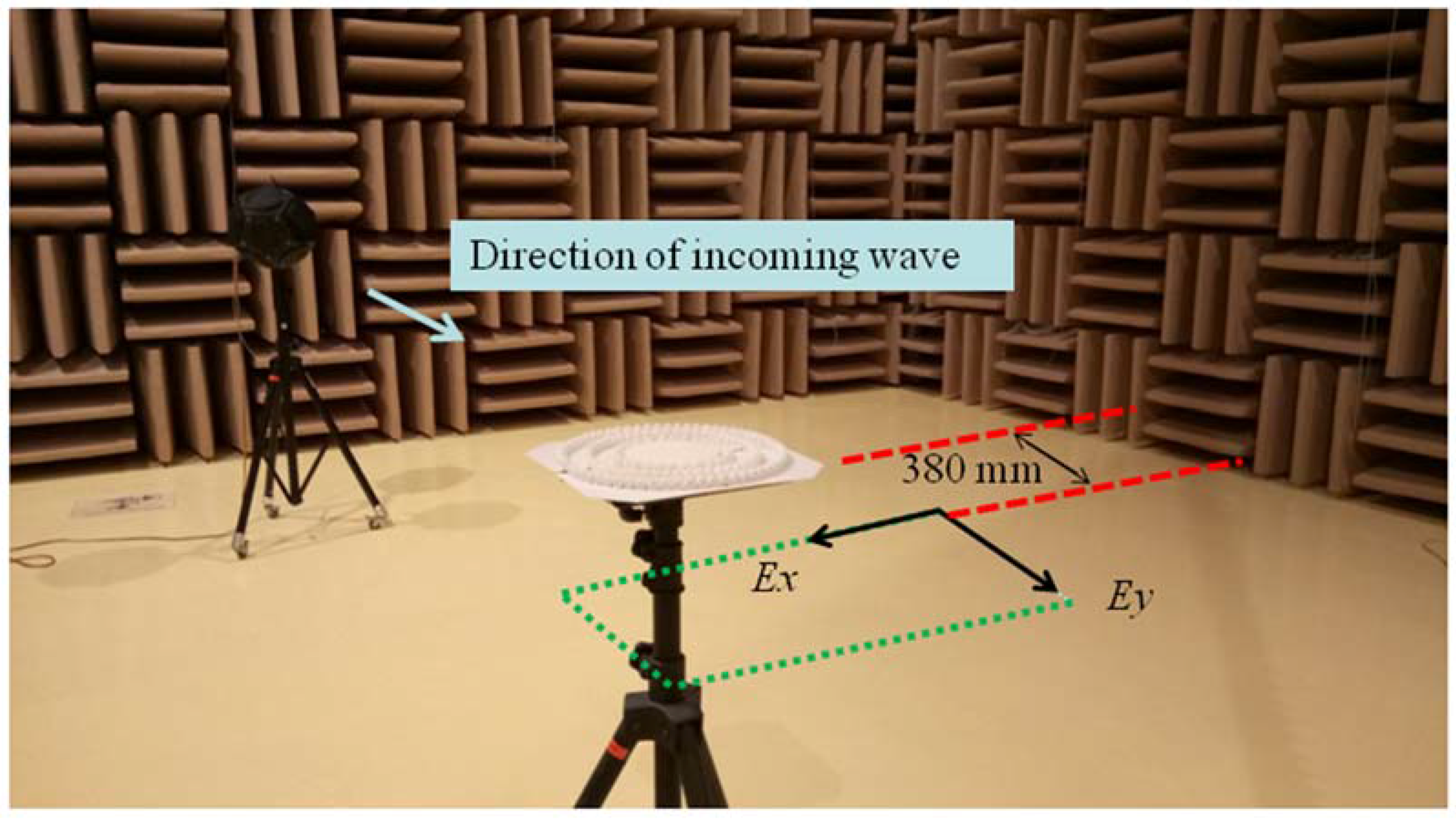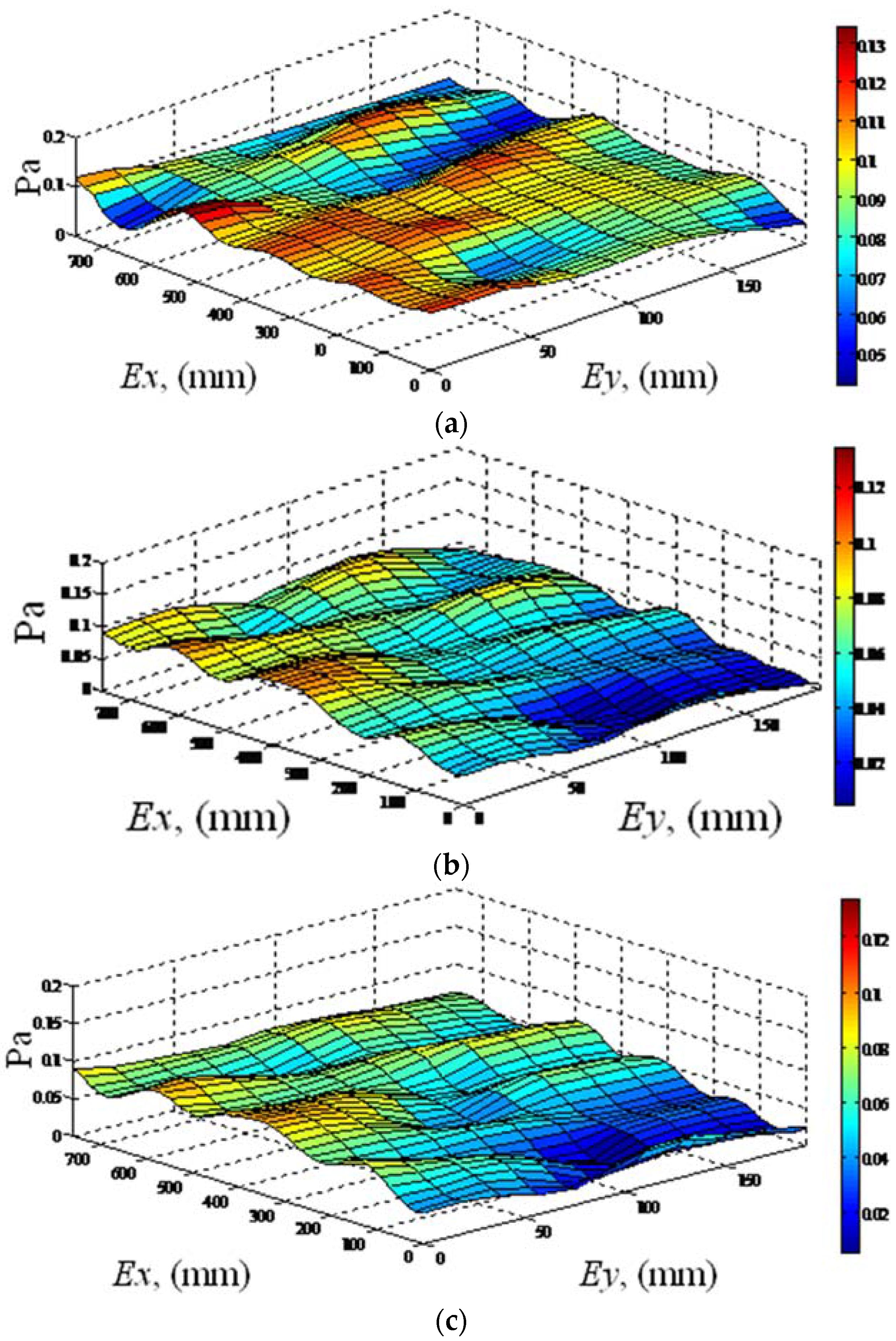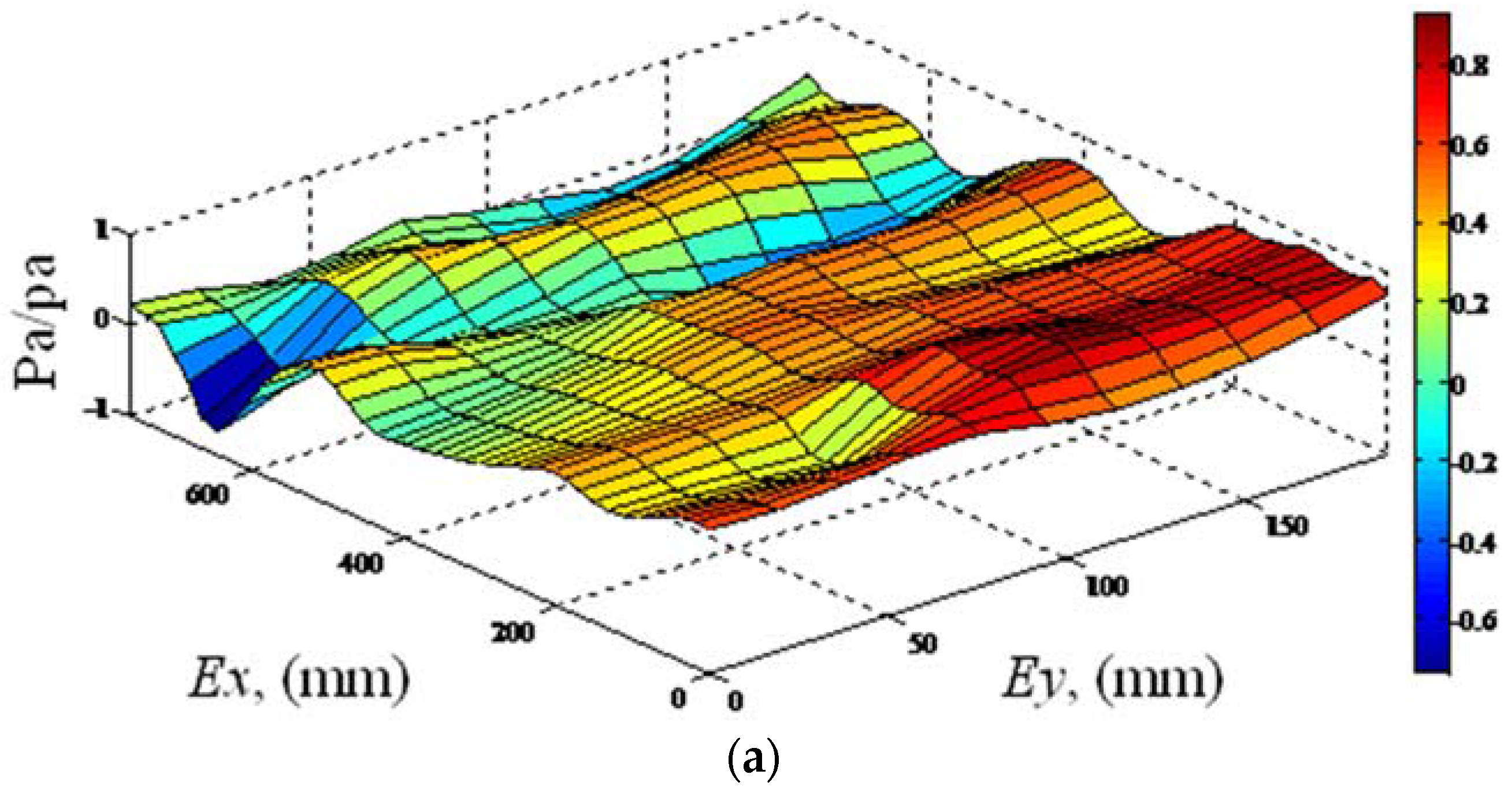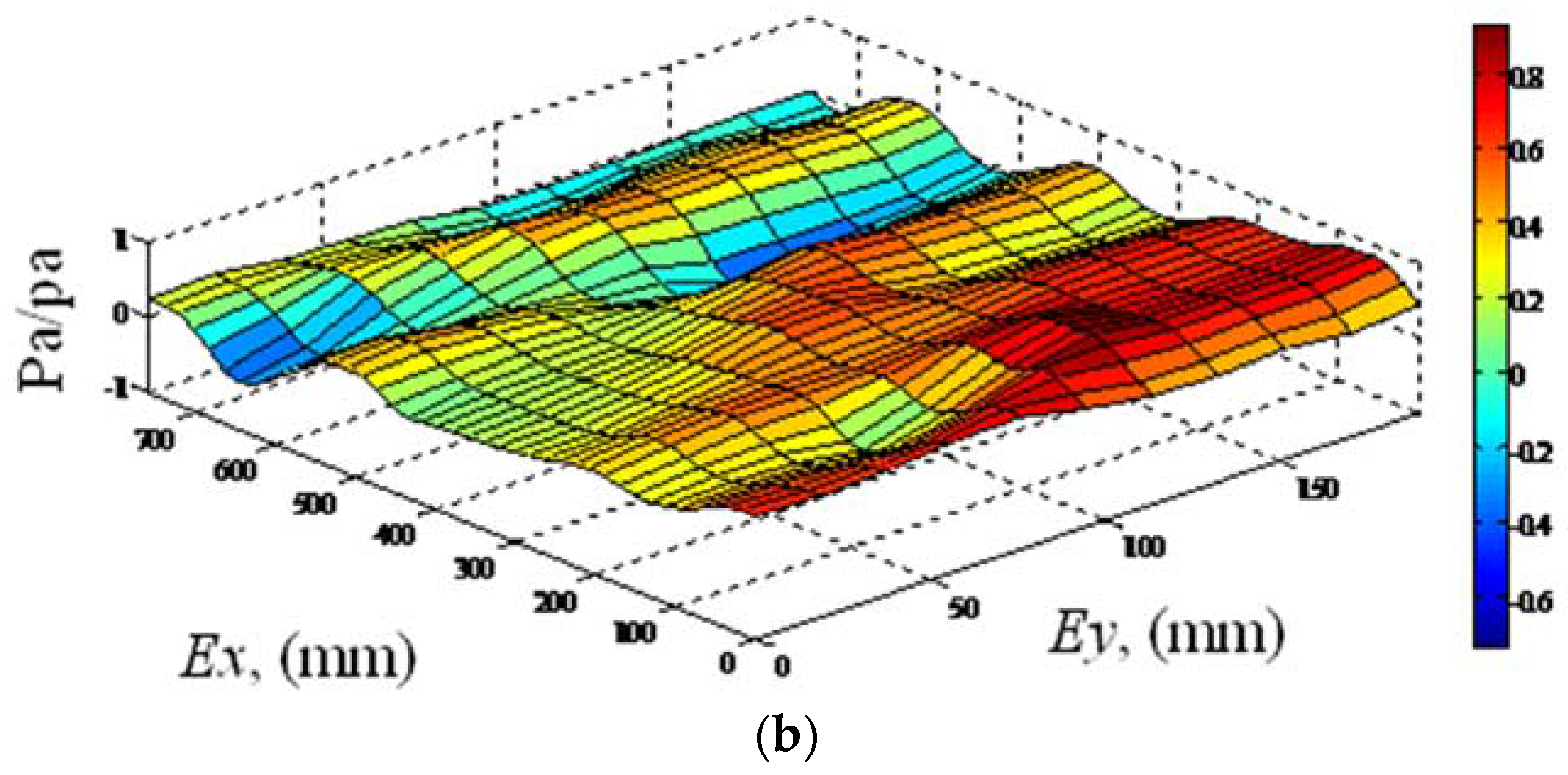2.1. The Design of a Circular Cloak Shell by Three-Dimensional Coordinate Transformation
Acoustic cloaking is an important application in acoustic engineering. Developing the means to control the propagation of sound waves has long been a goal of acoustic engineers. Transformation acoustics [
8] have been used in the form of a cloak shell to control the propagation of sound waves by imparting anisotropic material properties. This kind of device can be applied as a noise isolator for residential buildings and schools in the vicinity of highways or airports; however, it requires the ability to affect sounds in the audible frequency range.
This paper presents a novel meta-composite structure based on transformation acoustics, in which the transformation of spatial coordinates squeezes the transformed space into the cloak shell region, as shown in
Figure 1a. To produce an acoustic cloak for a three-dimensional object, we applied coordinate transformation in the radial direction,
, as well as the vertical direction,
, as shown in
Figure 1b. The coordinate transformation causes the real domain along the
direction to be compressed into the cloak shell region, resulting in the formation of a transformed region inside. The real domain is simultaneously compressed in the vertical direction,
, thereby extending the effect of the cloak from 2D to 3D. Thus, the cloaked region in
Figure 1b is free from the effects of incident waves, making it an ideal position for the placement of objects requiring cloaking. In the horizontal plane, as suggested by Chen et al. [
10], we used the spatial coordinate transformation and governing equation equivalence to determine the material parameters ρ and λ in the transform domain of a 2D coordinate circle cloak as follows:
where
and
are the mass density and bulk modulus, respectively, relative to the background media;
,
, and
are the position parameters of the coordinate system, as shown in
Figure 1b.
is a nonnegative real number defining the radial position,
lies between 0 to 2
π and
defines the vertical position. Function
is the coordinate transform function in the radial direction to be defined. Further, the vertical space is transformed and compressed along the vertical direction, as shown in
Figure 1b. For coordinate transformation in the vertical
direction, the transformation function in the vertical direction is selected according to the following:
. Here
is the scale factor (real constant) in the vertical
direction. In accordance with the methods outlined in [
10], and using the wave equation equivalence between the coordinate transformed domain and the outside field, the cloak shell material parameters of both radial
and vertical
directions in the transformed domain can be written as (see the
Supplementary Materials):
Following the above method, we designed the 3D acoustic circle cloak shell working in air. Firstly, in the horizontal plane, we selected the transform function
f of the cloak shell in the horizontal
plane as
, where the radial positions are
and
, and the cloak shell region along the radial direction is
. The transform function
f leads to
,
,
, and
. The above coordinate transformation procedure in the radial direction compresses the region in the real domain within
in the horizontal
plane into region
in the transformed domain. This process makes region
in the real domain non-existent in the transformed domain and transforms region
into a cloaked region. Objects that one wishes to cloak can be placed inside the cloaked region to protect them from being hit by incoming sound waves. Secondly, in the vertical
direction, we randomly selected
to obtain the coordinate transformation function in the vertical direction,
. Substituting the transformation function into Equations (2a) and (2b) provides the material parameters of the 3D transformed cloak shell as follows:
According to the above results, the material properties of the cloak shell along
,
, and
are spatially varying in three directions. The circular acoustic cloak shell is composed of an anisotropic inhomogeneous material. Since the acoustic impedance of the material is the primary factor determining the propagation behavior of waves through the medium; therefore, we use the guiding principle in the design of the cloak shell material. The structural design of the cloak shell is divided into three layers along the radial direction as plotted in
Figure 2. The three layers (
= 3, 4.5, and 6;
= 0~
) construct the cloak shell region; therefore, they will be physically realized by proposing meta-composite structures.
Substituting the spatially varied cloak shell material parameters
and
in Equations (3a) and (3b) into relationship
(the definition of specific acoustic impedance), we can obtain the required ratio of specific acoustic impedance of the cloak shell,
, in
,
and
, as shown in
Figure 3a–c. The diagram in
Figure 3 is plotted according to the relationships between the Cartesian coordinates and the cylindrical coordinate system on the horizontal plane as
and
, respectively. As shown in
Figure 3, the ratio of the specific acoustic impedance values of the cloak shell varies spatially in three different directions. A comparison of the values in
Figure 3a to those in
Figure 3c shows that, although they exhibit the same distribution, the variation ratios in the
,
, and
directions differ. The impedance values of the cloak shell vary spatially in the
and
directions, increasing from the innermost to the outermost layer. In the
direction, the impedance value is a constant. Furthermore, by substituting the designed material parameters
and
of the cloak shell obtained in Equation (3) into the phase velocity relationship
, the designed phase velocities in the
,
, and
directions within the cloak shell are obtained, as plotted in
Figure 4. As shown in
Figure 4, varying the velocity along direction
while keeping it constant in direction
allows for the manipulation of the propagation direction of the acoustic waves in the
–
plane within the cloak shell. The spatial variations of the phase velocity inside the cloak shell region are related to the coordinate transformation. The coordinate transformation makes the cloak shell become anisotropic and results in the spatial variations of the phase velocity. Through this mechanism, waves inside the cloak shell can be guided along a pre-determined path (as shown in
Figure 5, Path A); i.e., the propagation path of the waves can be made to avoid the original transmission path through the transformed region occupied by the cloaked object. In the vertical direction
, the effect of the coordinate transformation increases the phase velocity of the acoustic waves, as shown in
Figure 4c. Variations in the phase velocity cause the acoustic waves to propagate smoothly upward (as shown in
Figure 5, Pre-Determined Path B), thereby producing a cloaked space in the vertical
direction. In this way, the cloak shell causes the acoustic waves to propagate along the pre-determined paths and avoid hitting the cloaked object.
2.2. Meta-Composite Structural Design for a Three-Dimensional Circle-Type Cloak Shell
As shown in
Figure 3, the specific acoustic impedance values,
, vary in some areas of the cloak shell, which necessitates the use of a cloak shell capable of providing these specific impedance values. Here, we propose a meta-composite structure designed to provide different impedance values in the
,
, and
directions through the use of specific structural components. As previously described in
Figure 2, the anisotropic cloak shell is active by a three-layer meta-composite structure.
Figure 6 explains the composited block elements that form the cloak shell by the layer meta-composite structure. The block elements in the layer are designed according to the spatially anisotropic properties of the cloak shell through impedance design.
Acoustic structural engineering [
26,
27,
28] can be used to develop structural devices, such as tubes and cavities, in order to provide acoustic mass and acoustic compliance, respectively. Thus, the impedance value can be adjusted by altering the configuration of this structural device. As shown in
Figure 7a, we assembled block elements with cavities and tubes in three directions, the tubes acting as acoustic mass and the cavity in the center ensuring acoustic compliance. Each block element comprises a single cavity in the center with four tubes in different directions. These block elements provide the acoustic impedance value
. In the structure of tube, the physical law governing the motion of air inside the tube [
26,
28] is
, where
M is the mass of volume fluid inside the tube. After dividing the cross-sectional area
A of the tubes, the motion of air leads to
, which can be further expressed as
. Using the above, the relationship can be further explained as follows:
=
=
. In the structure of the cavity, the physical laws governing the compression of air being acted on by a force in a cavity [
26,
28] lead to the following equation:
. The value
is the acoustic mass or acoustic inertance,
is the acoustic compliance. Using the above properties, a block element comprising tubes and cavity structures provides the acoustic impedance value
in the respective
,
, and
directions as follows:
The first part,
is the acoustic impedance value supplied by the tube structure; the second value,
, is the acoustic impedance value supplied by the cavity structure. In Equation (4),
,
is the circular frequency,
is the density of the background medium (air), and
c is the wave speed in air. Values
A represent the cross section of the tubes and value
V is the volume of the cavity. Because tubes connected the cavity, forming as the flanged end in the cavity side, the effective length
is the original tube length plus the correction value of the flanged end [
27] as shown in
Figure 7b.
Equation (4) provides impedance values of the cloak shell in
,
, and
directions. The frequency of the meta-composite structure is set as 1000 Hz, an undistorted frequency for human hearing. Using the relationship
in conjunction with the specific cavity dimensions, the cloak shell can be represented using a three-layer metamaterial comprising a structural block element, as shown in
Figure 7. Note that
is the cross-sectional area of the individual element forming the cloak shell layers, where the element size
a of a specific layer in the study is presented in
Figure 7b. The design parameters were described in
Table 1. Because the metamaterial structure provides acoustic mass and acoustic compliance rather than acoustic resistance, the shell is able to store acoustic energy rather than consume energy and it has a low-loss nature.
Figure 8 explains the interior details of the meta-composite material structure, showing the interior details of block elements with rectangular cavities and tubes sliced by a horizontal surface in the
–
plane and by a vertical surface in the
–
plane, respectively. Based on the principle of Equation (4), the combination of cavity and tubes of the block element provides the acoustic impedance value
in the
,
, and
directions, respectively. The tubes connected the cavity without extending inside the interior of the cavity. In the design, the cloak shell structure element unit is composed of cavity and a pair of tubes series connected in the respective direction. They give the impedance performance as the Helmholtz resonator [
29].
Table 1 lists the design parameters of the structure. A total of 144 block elements were used in the cloak shell. The volume of the cavities was set as 27,000
for each layer. The largest size of the cavities was 30 mm, and the wavelength of the design frequency was 343 mm (1000 Hz,
c = 343 m/s); therefore, the size of the elements did not exceed 1/10 of the wavelength. The cloak shell structure elements were designed based on the principles of the long wavelength limit [
30] and the structure of the cloak shell could then be treated as an effective medium for incident waves. As per the anisotropic nature of the acoustic impedance values in three different directions, the designed block element tube lengths in three directions belonging to the cloak shell are plotted in
Figure 9. The spatial variations of the tube length around the circumference of the circle-type shell agree with the required impedance of the cloak shell in
Figure 3. Through the combination of the center cavity and different tube lengths in the
,
, and
directions, the proposed meta-composite structure precisely simulates the anisotropic material properties, which provide the shell structure for the 3D coordinate transformation cloak. It also describes the anisotropic material properties of cloak shell can be achieved indirectly through the impedance design.
2.3. A Numerical Simulation of the Cloak Effect in Practice Working Conditions
The cloak shell was subjected to a numerical simulation using ANSYS 14.0 [
31] in 3D in accordance with the specifications listed in
Table 1. The real object to be cloaked may present with different kinds of geometries and without fully filling the transformed zone. Based on coordinate transformation only in horizontal plane, previous research [
17] on 2D is not suitable for the acoustic cloak of a real 3D object. In this study, the numerical experiment was conducted with a circle-type cloak shell with a cylinder object inside the transformed zone of the cloak shell in three dimensions. The meta-composite structure of the cloak shell was modeled precisely without simplification in order to comply with real working conditions. The plane wave was set with a pressure amplitude of 1 Pa incident on a cylinder object (radius = 185 mm, height = 30 mm) concealed in the center, as shown in
Figure 10. The diameter of the cloak shell is 840 mm. We selected plastic as the material for the cloak structure to facilitate its fabrication. The 3D geometry of the object and cloak shell was built and enclosed inside a rectangular acoustic domain (5000 mm
2500 mm
100 mm) for the background medium (air). The density and sound speed of air are 1.2
and 343
, respectively. As shown in
Figure 11, the sound wave is incident on Surface A propagates forward and interacts with the object. By setting a radiation boundary at Surfaces A and B of the acoustic domain, there is no reflected sound wave in the acoustic domain. Aside from Surfaces A and B, other surfaces of the acoustic domain were assumed to be the free surface.
We applied 3D acoustic fluid element (Fluid 221) in the acoustic domain for use in complicated geometry [
32]. The 3D geometric model was meshed using a fluid structure interaction (FSI) interface [
31] to represent a fluid–structure interaction as plotted in
Figure 11. For the sake of accuracy, we used harmonic analysis by the full method to solve all of the system functions directly, rather than using the mode superposition method. The simulation model was solved and evaluated in the post-processing stage, and the pressure field of the whole system was evaluated at the respective frequency.
Figure 12,
Figure 13 and
Figure 14 presents the total wave field of the uncloaked object, cloaked object, and free field (only incident wave) cases at a 1/3 octave frequency of 800–1250 Hz. As can be observed in
Figure 12, in the uncloaked object case, incident waves of 800 Hz resulted in obvious wave scattering as compared to the free field. The sound field of uncloaked object case exhibits strong scattering in both the forward and backward directions. However, in the cloaked object case, the wave field at the same frequency also presented a complex disturbance, and the wave cloaking effect was not apparent.
Figure 13 shows a comparison of the field patterns between the uncloaked and cloaked object cases at a cloak shell design frequency of 1000 Hz, with the field patterns of the cloaked object clearly showing that the wave passed around the cloak shell and recovered behind the zone of the cloak shell, reconstructing the original wave field. After passing beyond the cloak shell, the wave fronts of the propagating waves were guided back to their original path by the cloak shell, which prevented the production of intense field disturbances outside the cloak shell. The cloaked field exhibited field patterns with less alteration in the overall field than in the uncloaked object case, the results having a similarity to a free field. These results could be attributed to the wave guiding effect of the cloak shell, and these findings verified the effectiveness of the meta-composite structure in acting as a cloak shell. The wave cloak spatially varied the impedance values of the cloak shell, successfully producing the cloak effect by changing the wave phase velocity of
and
along the horizontal
–
plane and in the vertical
direction, as described in
Figure 4.
As with the case at 800 Hz, the results at 1250 Hz in
Figure 14 show no apparent cloak effect. The cloaked object case, cloak shell concentrated the wave scattering energy and forming strong wave beam in both forward and backward directions. Those strong wave beams break the cloak effect. The field patterns, the wave propagating paths, and the resulting scattering fields of the cloaked and uncloaked cases of the incident wave at 1000 Hz are explained in
Figure 15. In the uncloaked case, the incident wave at the center path interacted head on with the cylinder object and produced a typical scattering field in both forward and backward directions. However, the waves in the outer path propagated straight forward unhindered. The scattering field, combining the waves of both paths, was composed of two rectangular high-pressure regions (Region A), which were attributed to scattered energy and wave diffraction. The object in the space shadows the incident wave and forms the Low-Pressure Shadow Region B. This makes obvious pressure disturbance in the sound field and states the uncloaked condition. In the cloaked case, the incoming wave on the center path was guided by the cloak shell and was smoothly restored after passing through the object. These mechanisms avoid the strong scattering effect of the object. Within the unaffected waves in the outer path, the total scattering field of the cloaked case showed flat wave fronts. The pressure field patterns clearly showed more uniform field patterns in both the forward and backward scattering directions in Region C, evidence that the cloak shell guided the waves and created the cloak effect. These results matched the theoretical findings presented in [
9]. Our simulation results agreed with the original design concept of transformation acoustics [
8] and served to verify the effectiveness of the proposed metamaterial structure of the cloak shell design.
In the investigation of the scattering field, the pressure values with and without the cloak were measured at 11 section lines along the wave fronts in the scattering field. Considering the incident wave length
and the linear dimensions of the object, we chose the sound field in the far field [
33] for the evaluation of the cloak effect. Taking the far field factor into account, as shown in
Figure 16, the positions of the section lines ranged from
x = −1000 mm to
x = −1500 mm at 50 mm intervals; the width of the evaluated path was 2000 mm in the
y-direction. In the
z-direction, the positions of the section lines are at half the height (
z = 15 mm) of the cloak shell. To evaluate the cloaking performance of the shell, we employed the concept of average visibility,
, which is a more convenient metric than the traditional scattering cross section [
17]. The definition of
is as follows:
where
and
represent the maximum and the minimum pressure values, respectively, along the individual wave fronts measured at section line j. Parameter
N is the total number of wave front section lines included in the analysis, which is positively correlated to the visibility of the object. An increase in the scattering disturbance in the wave field is an indication of greater visibility. If no acoustic waves are present in the environment, then no pressure difference (between the maximum and minimum pressure values) exists in the field and the value of
is zero.
Figure 17 presents the averaged visibility values obtained in the cloaked and uncloaked object cases from 630 to 1600 Hz. The scattering field was investigated along the 11 path lines in cases involving a cloaked object and an uncloaked object. Clearly, the cloaking ability of the shell structure is quite good at its design frequency at 1000 Hz. The reduction in average visibility values to 20% of that obtained from an uncloaked object. As shown in
Figure 17, the results obtained at the frequency of 1000 Hz clearly demonstrated the effectiveness of the acoustic cloak shell. However, in frequency bands lower than 1000 Hz, the decrease of averaged visibility value is not available. Also shown in
Figure 17, at higher frequency bands of 1125 Hz to 1600 Hz, the scattering reducing and wave cloak effects of cloaked object case were still unapparent at these frequencies. It seems then, with the present circle-type cloak shell, the meta-composite structure could not provide enough wave-guiding ability at other than the design frequency. In other frequencies, the effects of the wave guiding were not readily apparent. It was therefore concluded that, for the circle-type cloak shell, the most effective frequency of the present meta-composite cloak shell structure was the design frequency of 1000 Hz. Although the cloak shell still provided a working ability at other frequencies, the wave guiding effect was not as effective as at the design frequency. The reason for this could be that the small curvature radius of the circle-type cloak shell created a sharp angle in the wave guiding path and corrupted the cloak effect at other frequencies. Less effective wave guiding ability did not allow for wave guiding at a pre-determined path in a circle-type cloak shell.
Aside from the total field, we also investigate the scattering sound intensity of cloaked and uncloaked objects.
Figure 18 plots the positions of the sampling line, where we sample the circle of sound pressure values around the object at a distance
d = 1.2 m from the object in the far field positions. We evaluate the intensity of both the total and the normalized field. The magnitude of the normalized field is processed by substrate the incident field from the total field, resulting in scattering intensity only produced by the object.
Figure 19 plots the intensity polar pattern diagram of the total sound field and the normalized field (scattered field of the object) with an incident wave frequency
f = 800 Hz. The acoustic wave incident from the polar angle zero interacts with the object in the middle and then passes through at 180 degrees.
In
Figure 19a, the curve of the uncloaked object shows a peak scattering energy in forward directions of 150 and 210 polar degrees and backward directions of 45 and 315 polar degrees. Compared to the polar intensity diagram of the cloaked and uncloaked object cases, the cloaked object case does not exhibit any obvious scattering reduced effect and the scattered intensity amplitude exhibits the same pattern with the uncloaked case in all directions. In the normalized plot (scattered field of object) of
Figure 19b, intensity values describe the same results. It can be reasoned that the design working frequency of the meta-composite cloak shell is 1000 Hz, which is an inappropriate incident wave frequency for reducing the cloak abilities. In the incident wave frequency
f = 1000 Hz, as shown in
Figure 20a, the cloak shell obviously suppresses strong scattering in both forward (150 degrees; 200 degrees) and backward (15 degrees; 345 degrees) directions of the uncloaked object case. This explains a good acoustic cloak effect. In the cloaked object, the peak field disturbances (15 degrees; 345 degrees) are reduced to about one quarter the values of the uncloaked object case. The effect can also be observed in
Figure 20b of the normalized results. As described in
Figure 20b, the cloak eliminates the strong backward scattering of the uncloaked object and successfully guides the incident wave. In addition, reducing the scattered energy in the all-around directions explains the wave guiding abilities of the cloak shell design. These results consist of the original design concept of the cloak and form the cloak of the object from the incident wave. Looking at
f = 1250 Hz in
Figure 21a, the uncloaked object results in a sharp scattering beam at 0, 175, and 195 degrees of direction. The cloaked object case in the frequency exhibits strong scattering in both 0 and 180 polar degrees.
Figure 21b also describes the same finding. In this incident wave frequency
f = 1250 Hz, the cloak is less effective due to a high long wavelength limit. In summary, the polar intensity exhibits the same conclusion as the average visibility and field pattern results, thus verifying the effectiveness of the acoustic wave cloak’s proposed design and acoustic invisibility. The polar patterns of the cloaked object in
Figure 21 are asymmetric with respect to the propagating direction of the incident wave. It can be reasoned that, as an incident wave frequency
f = 1250 Hz, the cloak is less effective due to the high long wavelength limit. The structural elements of the cloak shell act as individual scatters viewed by incident acoustic waves. They produce complex multi-scattering waves. However, the dimension of the cloaked object in the vertical
z-direction is limited, and these complex multi-scattering waves produce complicated out of plane scattering. The out of plane scattering waves in the vertical direction still affect the final sound field. Therefore, the results of cloaked polar intensity patterns are asymmetrical at a high frequency.
Based on the concept of an acoustic scattering cross section [
33,
34], we define the parameter
CSV (cross section value) for qualifying the amount of scattering energy of the object and cloak. The incident wave delivers energy that is
, where
is the summation of incident wave sound intensity values on surface
. The area
is the rectangular area normal to the direction of the incident wave as shown in
Figure 22a. The scattered energy is evaluated by
, where
denotes sound intensity values of the scattered wave summarized around the enclosed cylinder surface
described in
Figure 22a. The surface
encloses around the object inside. The parameter
CSV is as follows:
The sound pressure values for calculating
and
are sampled at straight and circular lines in the middle height position of surfaces
and
, as plotted in
Figure 22a. The cross-section values of the uncloaked and cloaked objects from 800 to 1250 Hz are shown in
Figure 22b. At 800 Hz, the
CSV values show an unapparent difference between both cases. The cloak effect is unavailable at this frequency. This explains the same result as the polar plot shown in
Figure 19, but in 1000 Hz,
CSV of the cloaked object case is 62% of the uncloaked object case. This provides evidence as to the effectiveness of the cloak design and explains the cloak ability of the cloak shell in a scattered field. The transformed region prevents the incoming wave from interacting directly with the object and reduces the production of strong scattering. In the high frequency of 1250 Hz, the results of the cloaked object case in contrast exhibit higher
CSV values than in the uncloaked case. As shown in
Figure 21, the strong scattering beam’s forming of the cloak object in this frequency breaks the cloak. This brings the same conclusion in the scattered field
CSV results.
